Adventurous Kate contains affiliate links. If you make a purchase through these links, I will earn a commission at no extra cost to you. Thanks!
When it comes to the best Italy landmarks to see before you die, the list is daunting. Are you really going to be able to make it to Lake Como and the Vatican, Pompeii and the Ponte Vecchio, Cinque Terre and the Canals of Venice?
It’s impossible to see all of Italy in a single trip. And the single most common mistake I see travelers make in Italy is planning way too much in too little time — a zoom-across-the-country itinerary seeing so much and feeling so little. (Oh, and you can read the full list of Italy travel mistakes here!)
So which landmarks of Italy are worth visiting? You’ve got your major churches, historic landmarks, and piazzas, but there are a lot of gorgeous natural wonders that often get overlooked, but are worth visiting as well.
Here are some of the best Italy landmarks. Hope you enjoy planning your Italy trip!
Table of Contents
Italy Landmarks Map
Above is the full map of Italy landmarks, via Google Maps. You can also access it here.
Use this map to help you plan your dream Italy itinerary — without running yourself ragged in the process!
And now, on to the list of the best Italy landmarks to visit once in your life. You’re going to love these places.
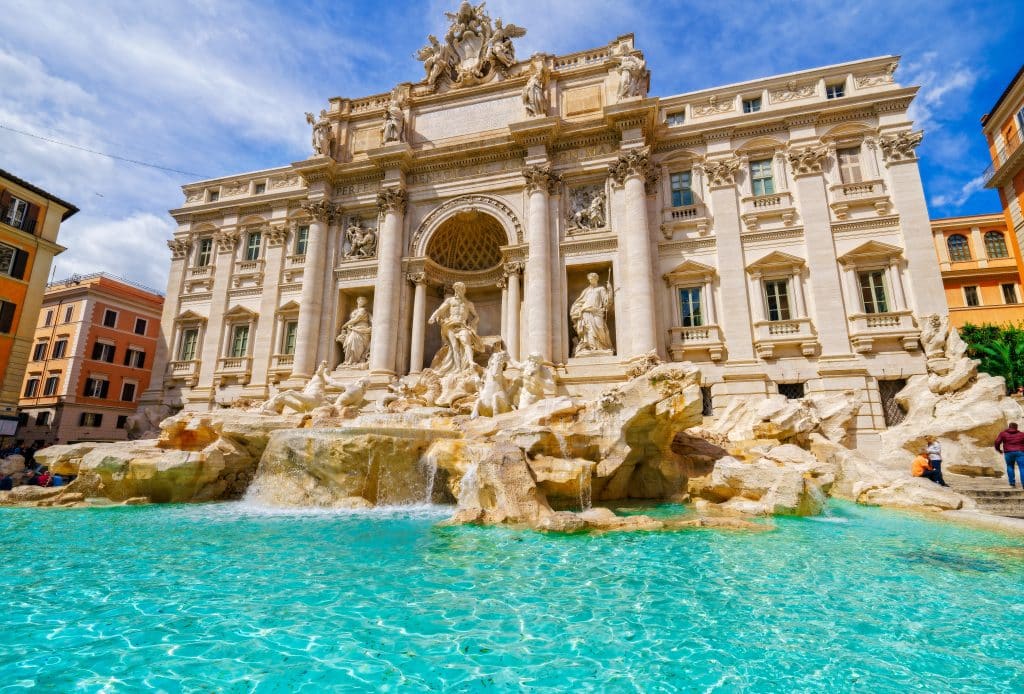
Trevi Fountain
Submitted by Claire of Europe in Winter
When you’re visiting Rome, don’t miss the incredible Trevi fountain! Located in the Trevi district of Italy’s capital city, on a busy, largely pedestrian intersection, this architectural marvel has been impressing tourists for centuries.
The fountain you see today dates back to the 18th century, although there has been a water source on this site since 19 BC, in the Ancient Roman era. It’s actually the oldest water source in the entire city.
It was remodeled in the 18th century by order of Pope Clement XII, who wanted to show off the city’s grandeur by way of a showstopping fountain. His idea certainly worked, as it remains one of the best landmarks in Italy to this day!
Showcasing various legends, the entire image of the Trevi fountain is built around the concept of “taming the waters.” Statues of gods Oceanus, Abundance and Health all stand around the fountain and represent using and living with water.
It’s traditional to throw coins into the fountain; legend has it that if you throw one, you’ll return to Rome, if you throw two, you’ll fall in love with an Italian and if you throw three, you’ll marry them! These coins (totaling around €1.5 million or $1.7 million per year) are collected periodically and donated to charity.
The fountain has appeared in many films and TV shows, including La Dolce Vita and To Rome With Love, which has helped it maintain its status as one of the very best things to see in Rome. If you’re visiting in the summertime, it’ll likely be teeming with tourists, but if you’re on a winter city break to Rome, you’ll find the crowds much more manageable.
Read More: Where to Stay in Rome: Best Neighborhoods & More
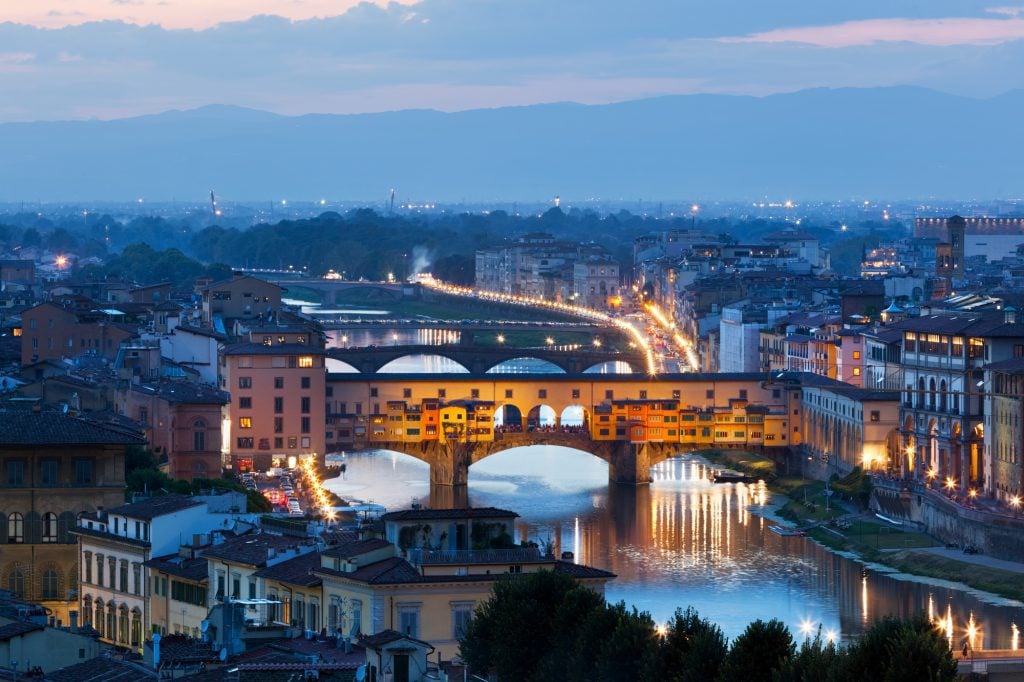
Ponte Vecchio
Submitted by Amber of Amber Everywhere
Stretched across the Arno River in Florence is Ponte Vecchio, the only bridge in Florence that survived World War II. Since its construction, Ponte Vecchio has served as a sort of local marketplace. Vendors would sell everything from meat to gold, though butchers were banned in 1595 as part of a measure to clean up the bridge. That decree remains in place to this day, so now only goldsmiths and jewelers are permitted to operate on Ponte Vecchio.
A bridge was first constructed in this spot along the river in 996 AD, but the current structure was completed in 1345 AD. This example of living history is a must-see on any trip to Florence, and experiencing places like Ponte Vecchio is one of the top reasons to visit Italy.
When you walk across the bridge, you’ll see large display cases with gold and high-end watches, all a minimum of 18k. If you’re not in the market for some jewelry, the bridge is a wonderful place to stroll and watch the sunset. It’s worth noting, however, that the best place to see Ponte Vecchio is actually from the next bridge down the river, Ponte Santa Trinita.
If you’re lucky, you may experience Ponte Vecchio while listening to a particularly talented street performer sing or play a traditional instrument. Be sure to toss them a few coins if you enjoy their performance, and remember to take a video so you can capture the entirety of the experience for your loved ones at home.
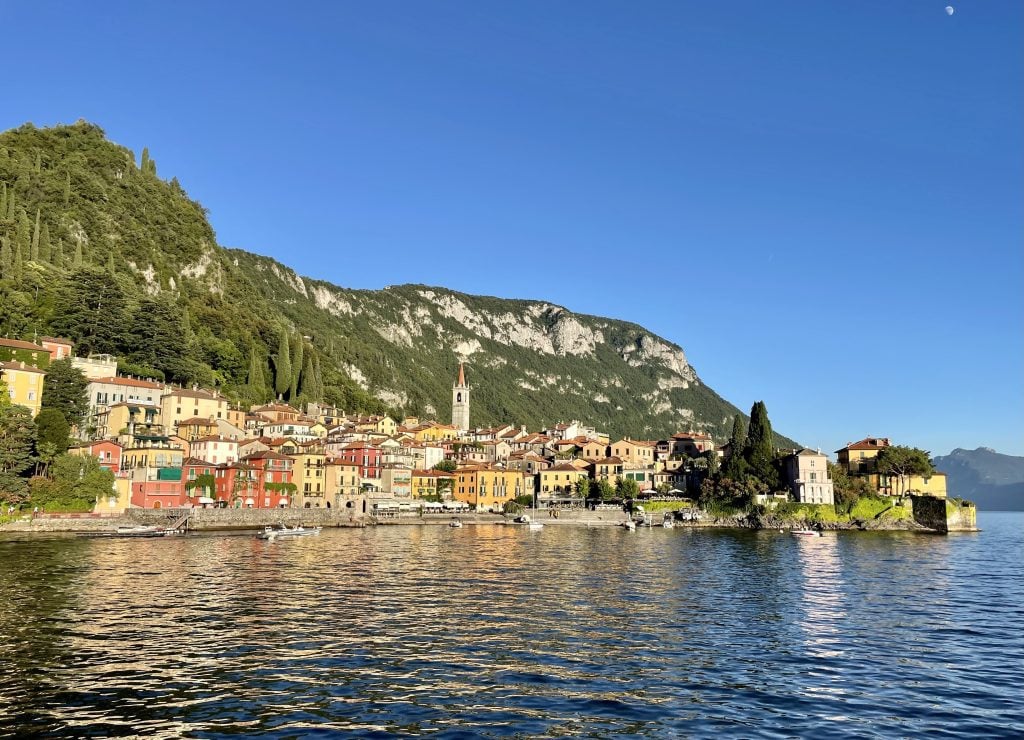
Lake Como
One of the most beautiful places to visit in Northern Italy is Lake Como, a world-famous lake surrounded by mountains. Nestled in between Italy and Switzerland, Lake Como is home to dozens of beautiful and interesting towns.
George Clooney famously made Lake Como his home (and encouraged Ocean’s 12 to be shot here). But you don’t have to be a movie star to enjoy the glamorous lifestyle on Lago di Como.
The easiest gateway to Lake Como is the town of Como, which is less than an hour by train from Milan. But once you arrive, hop on one of the many ferries to explore Como’s smaller, prettier towns, like Bellagio or Varenna. Because the lake is Y-shaped, it’s faster and much more beautiful to get around by boat.
And once you’re here? It’s all about you, darling! Shop for Italian wares in local boutiques. Have a tagliere at an outdoor cafe and watch the sunset turn the villages gold. And if you’re visiting during a hot summer day, take one of the many cable cars up into the mountains for beautiful views and cooler temperatures.
Raise a glass of Franciacorta, the local sparkling white wine, because you will have a day to remember at Lake Como!
Read More: Three Weeks in Northern Italy: An Itinerary
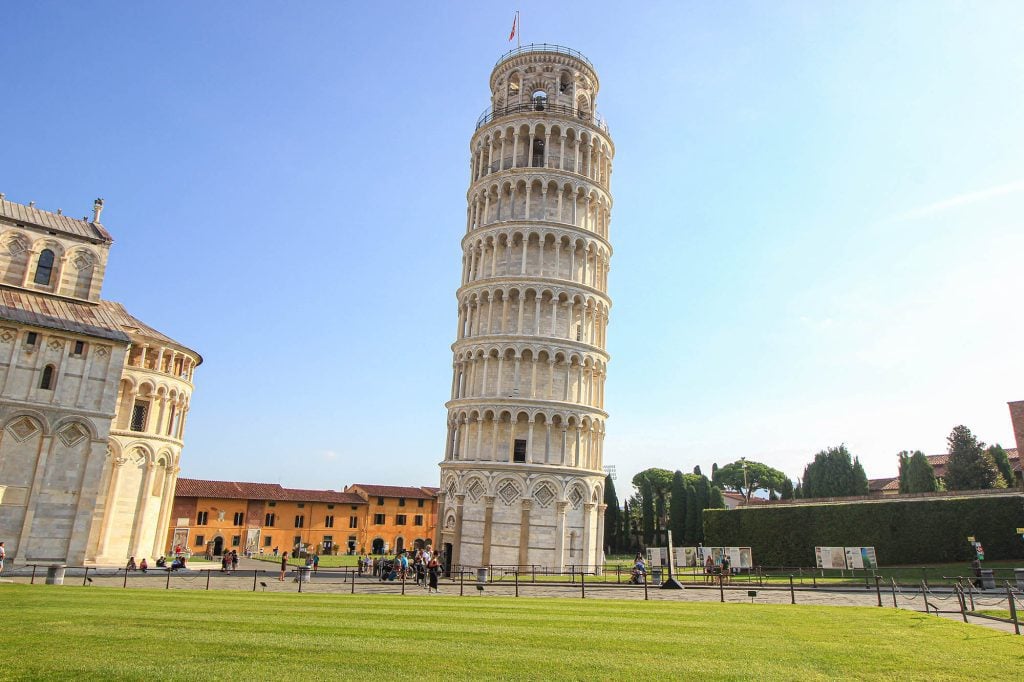
Leaning Tower of Pisa
Submitted by Martina of PlacesofJuma
The Leaning Tower of Pisa is definitely one of the most famous landmarks in Italy and moreover a place to visit at least once in your life! This remarkable attraction is located in Pisa in Tuscany, which is also home to an international airport, if you are planning to come by flight.
Built between 1173 and 1372, the Leaning Tower of Pisa has fallen into disrepair. Many years later, between 1990 and 2001, this free-standing bell tower had to be closed completely because its slope was too dangerous and needed restoration.
Finally, the tower has been straightened by 4 degrees, but don’t worry, the tower is still visibly curved, which you can see in all the iconic images.
Together with the Cathedral, the Baptistery, and the Cemetery, which are all located in Piazza dei Miracoli, the Leaning Tower of Pisa is a UNESCO World Heritage Site. Admission to Piazza dei Miracoli is free of charge, and so is taking pictures of the Leaning Tower.
However, climbing to the top of the tower is also a unique experience, as the view from the top is breathtaking. Since the Leaning Tower is one of the most famous Italy landmarks, there is always a long line — be sure to book ahead!
Read More: Best Day Trips from Florence
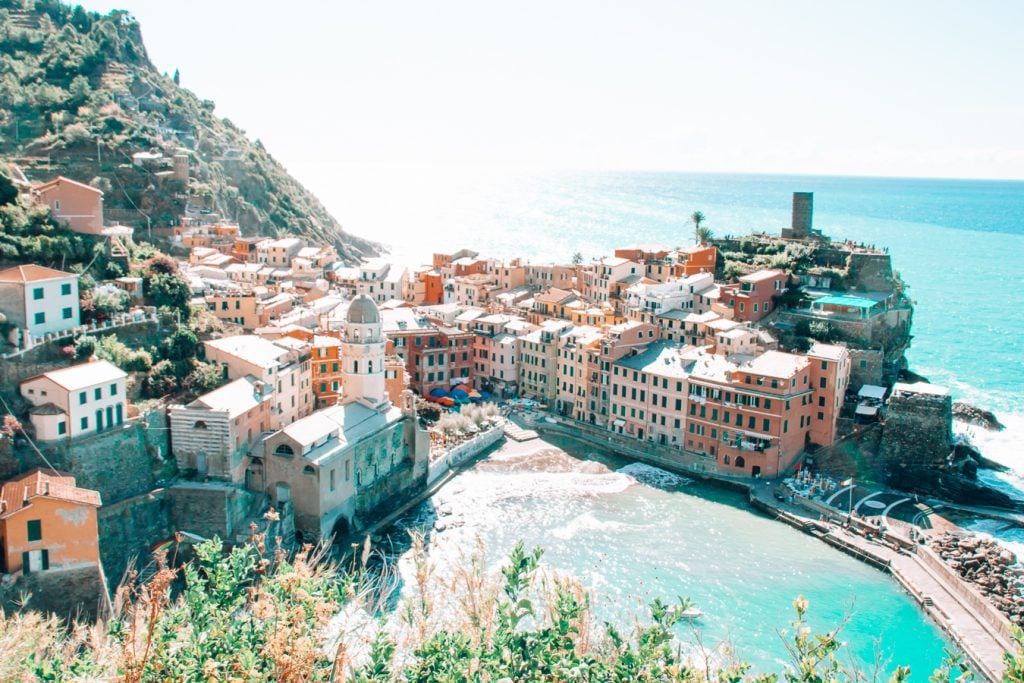
Cinque Terre
Submitted by Dymphe of Dym Abroad
One of the best landmarks in Italy to visit is the area of Cinque Terre. This UNESCO World Heritage Site is located in the region of Liguria. Cinque Terre consists of five villages: Monterosso al Mare, Vernazza, Corniglia, Manarola and Riomaggiore.
The villages are all very beautiful to see, and the colorful houses are picturesque. Furthermore, there are many Instagrammable places in Cinque Terre that will make some of the best photos of your trip.
Each village has a unique aspect that makes it great to visit. For example, Vernazza has beautiful viewpoints, and Monterosso al Mare has a long, beautiful beach.
An iconic restaurant to visit in Manarola is Nessun Dorma, which has one of the best views in Cinque Terre (as well as beautiful bruschetta!).
It’s easy to travel between the villages, as they’re all connected by train and there’s a pass that allows you to make unlimited train journeys between the villages. And if you’d like, you can hike between the villages for even more beautiful nature and viewpoints.
Cinque Terre is easily accessed by train from cities including Genoa, La Spezia, and Pisa.
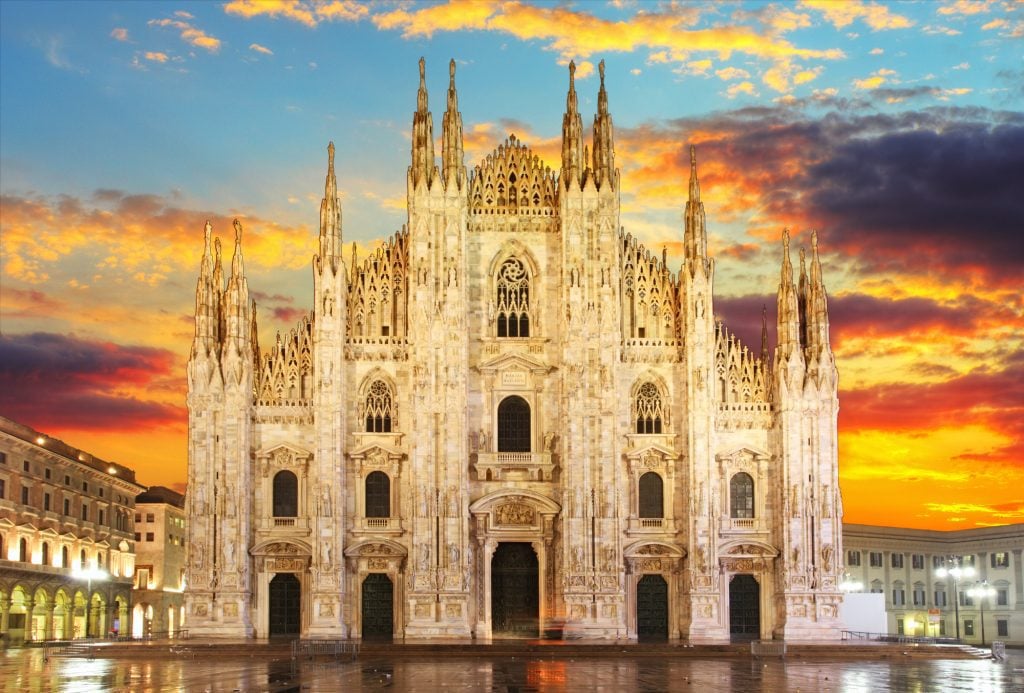
Milan Duomo
Submitted by Lowri of Many Other Roads
The Duomo in Milan is a must-visit landmark when traveling to Italy. It’s not only one of the largest churches in the world, but also an iconic architectural masterpiece that will take your breath away.
The stunning facade makes this cathedral truly awe-inspiring. Inside, you’ll find intricate artwork that captures the beauty and grandeur of the structure.
The Duomo’s history is just as captivating as its architecture. Construction began on this church in 1386 and it took nearly 600 years to complete! It took several generations of architects, artisans, and sculptors who worked tirelessly over the centuries.
No trip to Milan would be complete without visiting the Duomo. You can explore its grandeur from the outside, and also pay for tickets to tour the interior or ascend to the top of one of its many spires for an incredible view of the city.
In the summer season, it is worth buying skip-the-line tickets in advance. And as this is a religious building, make sure your shoulders and knees are covered, or they will not let you in.
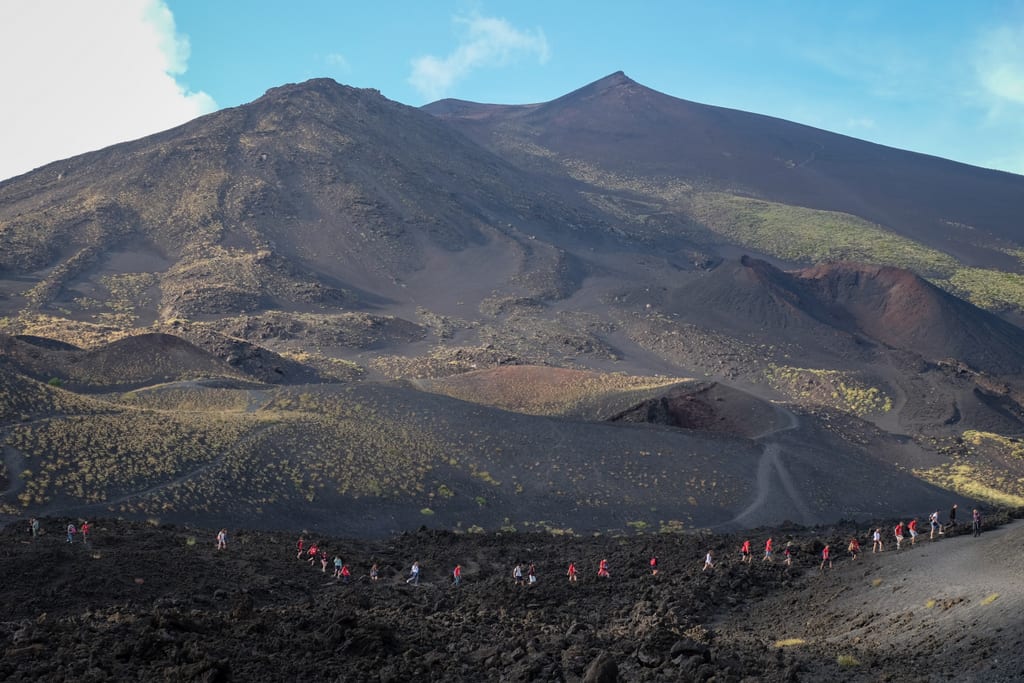
Mount Etna
Submitted by Annabel of Smudged Postcard
Mount Etna is the best-known sight on the Italian island of Sicily. Seen on the flight into nearby Catania, this active volcano is a constant presence to those who live on and visit the island.
Standing more than 3,000 meters above sea level, Mount Etna is a must-visit destination for anyone visiting Sicily. There is a cable car to the summit of the mountain, but hiring a guide and exploring some of the lesser-known areas of this national park is a more rewarding way to understand Mount Etna.
There are lava bombs to discover, ice caves to explore, and vast lava fields and slopes to hike. Of all the brilliant things to do in Sicily with kids, this mountain is, without doubt, one of the most exciting destinations in Eastern Sicily.
The volcano can be visited on a day trip from Taormina or Catania, cities that have experienced the force of the volcano firsthand on more than one occasion. There are refuges to stay in for those looking for a longer hiking experience, but there are also hotels at all price ranges in the foothills of the mountain.
The soil around Mount Etna is rich in nutrients making the region a popular destination for wine production. There are many wineries to visit in this area, as well as wine hotels.
Read More: Where to Go in Eastern Sicily
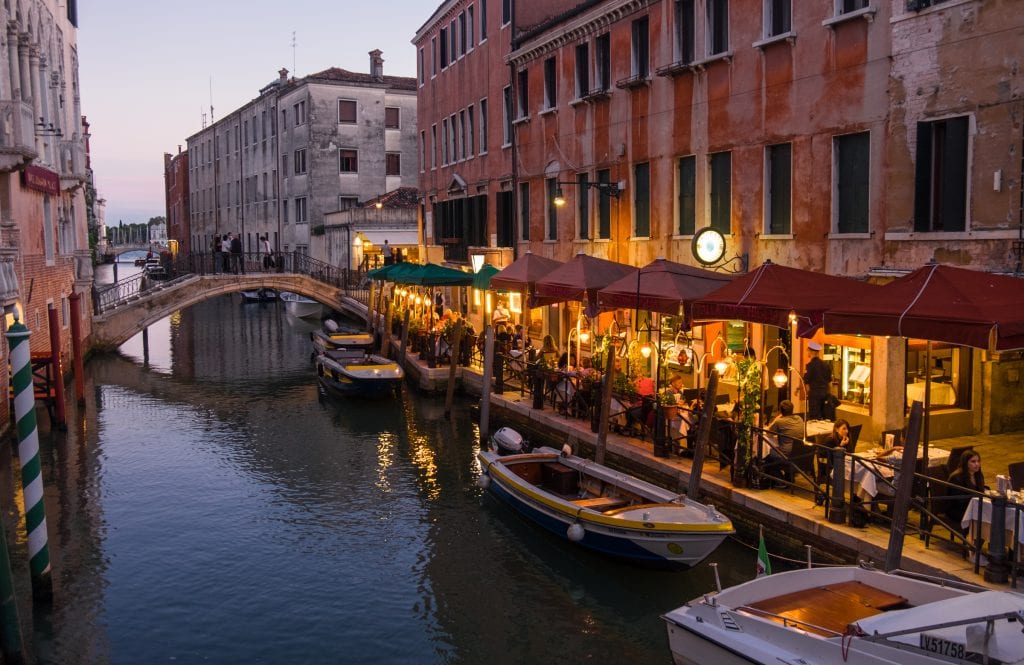
Canals of Venice
Submitted by Lavinia D of Continent Hop
When it comes to a city of romance like Venice, surprisingly, numbers speak more than anything. This is the city where 118 islands are combined together with around 150 canals and 400 bridges. So, of course, the canals of Venice make the city what it is today — a perpetually popular destination in Italy.
You will find so many things to do and places to see around the Grand Canal that it is a must for every Italy itinerary.
The best way to soak in the grandeur of sights around Venice canals is to ride a vaporetto — a floating public transport system in the city. These boats essentially function as buses in Venice! Opt for Line 1, as it is slower and will let you cover everything from the breathtaking Santa Maria della Salute to the centuries-old Rialto Bridge.
You may have heard that gondola rides are popular in Venice, and they are so because of the numerous movies they have been featured in. While you won’t go far, it’s a romantic way to take in the quieter, more intimate canals that the vaporetti are too big to access.
No matter how you choose to explore the canals of Venice, you’ll be enchanted by this incredible Italy landmark.
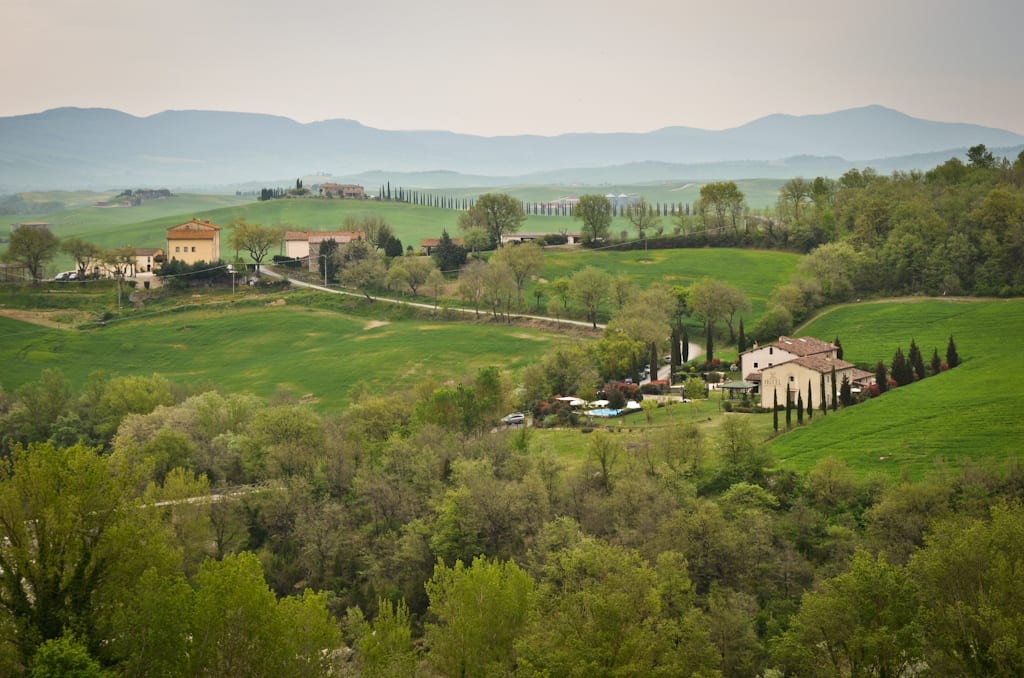
Val d’Orcia
Submitted by Anita from Anita Beyond The Sea
When it comes to Italy’s natural wonders, there are few places as beautiful as the Val d’Orcia. Situated in the South of Tuscany close to Siena, the Val d’Orcia is well known for its picturesque small villages, rolling hills and endless cypress roads that seem plucked directly from Renaissance famous.
Even though Val d’Orcia is about the same size as Chicago, the landscapes vary quite a bit. From the lunar fields of Biancane di Leonina, to the famous cypress lanes of Poggio Covili or Agriturismo Baccoleno, it’s all dazzling to the eye. Spring brings red poppies atop the green hills; winter brings misty mornings; summer brings gold to the landscape.
And how not to mention the beautiful villages. The romantic town of Pienza is probably the most beloved, and for good reason, but also Montalcino, known for its Brunello wine, and Bagno Vignoni, famous for its thermal spas, each deserve a quick stop. You can visit independently with your own car, or visit them all on a tour from Florence.
These villages are also known for their culinary excellence. Pici are a must to try. A hand-stretched pasta similar to spaghetti, they are perfect with pancetta (bacon) or cacio e pepe (cheese and pepper).
Would you like to know more about what to see in the valley? Be sure to check out the Val d’Orcia most iconic spot, and put together an itinerary to figure out your time in this beautiful place.
Read More: Into the Val d’Orcia
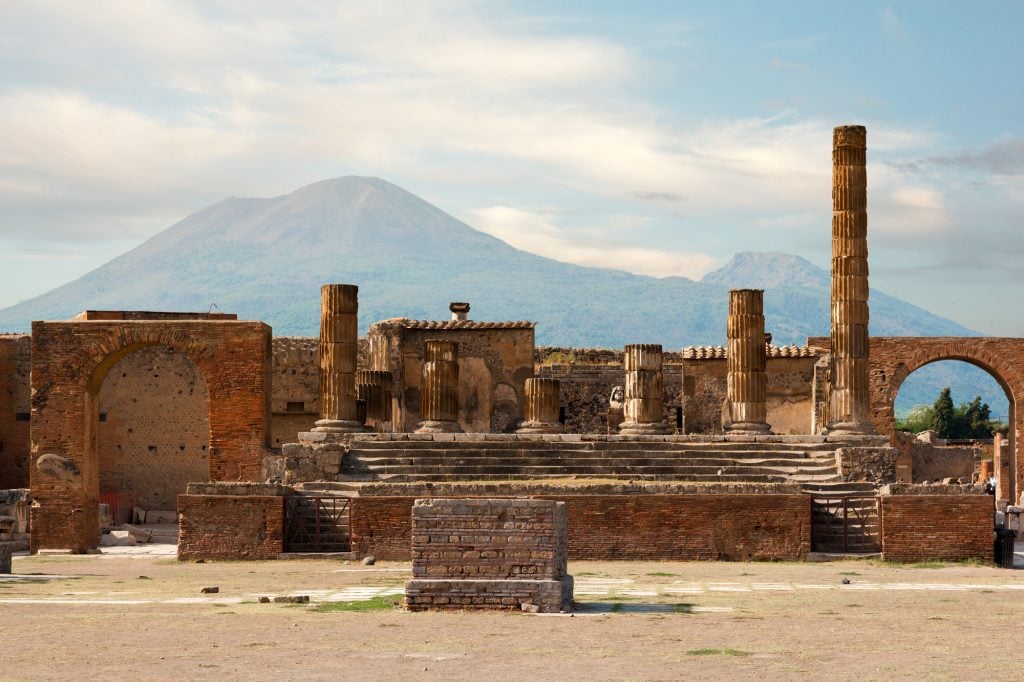
Pompeii
Submitted by Cris from LooknWalk
When Mount Vesuvius erupted in 79 ACE, it wiped out nearby cities, including Pompeii. Pumice and ash fell on its streets and buildings, killing around 3,000 people; the rest of the population had already fled.
The entire city remained frozen in time until 1748, when a surveying engineer discovered it. Today, it’s an excavation site and outdoor museum, easily reachable from both Rome and Naples. It’s one of the few ancient cities in the world that have been preserved in detail, offering the possibility to see how people lived during those times.
When planning to visit Pompeii, remember it’s an entire city, so plan accordingly: wear good walking shoes, bring a water bottle, and, if you visit in summer, a bandana or hat is vital. Shade is limited here.
If you aren’t opting for a guided tour with an archaeologist and prefer to visit Pompeii on your own, make sure to tick some of the most important attractions in Pompei.
The main square of a Roman town, the Forum, is surrounded by various temples, shrines, and stores. Enclosed by colonnades, the main buildings around it are the Temple of Jupiter, the Basilica, and the Temple of Apollo.
The House of Menander is a large and very well-preserved house that once belonged to a merchant. The interior walls are decorated with scenes from Homer’s Iliad.
The House of the Vettii is probably the most interesting in the city and preserves some of the best frescoes and still has some of its original marble decoration. The massive amphitheater at the far end of the city seated 12,000 spectators and is the oldest surviving Roman amphitheater, built before Rome’s Colosseum.
Villa dei Misteri, outside of the main excavation site, contains some of the finest surviving ancient paintings.
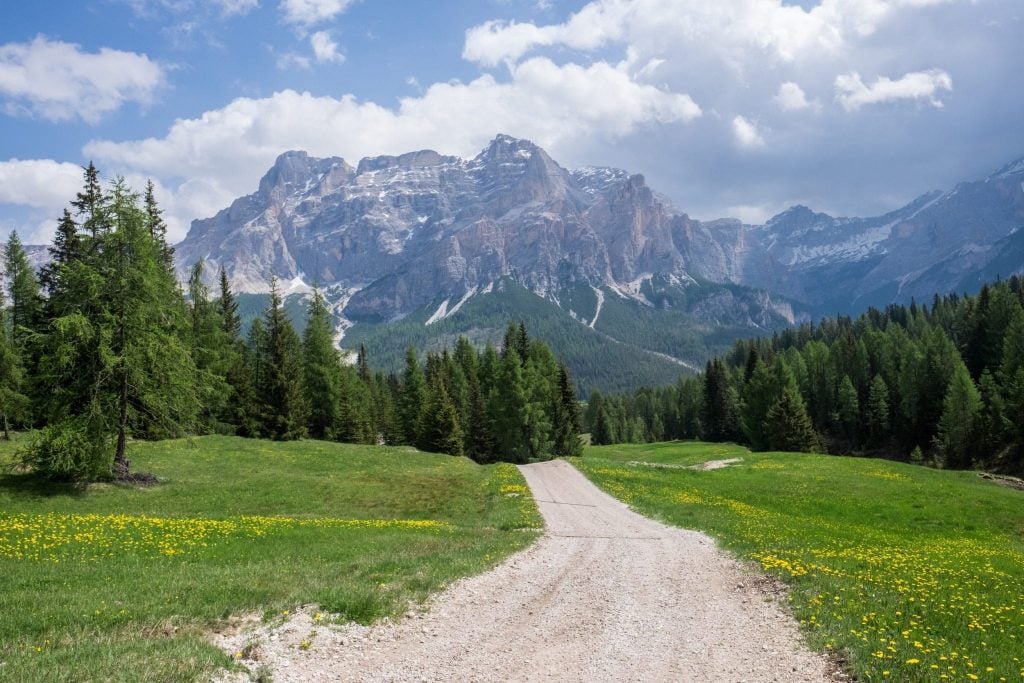
Dolomites
Submitted by Diana of Travels in Poland
Located in northern Italy, the Italian Dolomites are one of the most beautiful and picturesque mountain ranges in the world. Listed as a UNESCO World Heritage Site, the Dolomites have jagged peaks, cliffs, and numerous valleys, which holds town and villages that attract tourists throughout the year.
The Dolomites have a unique geological formation, as they are a type of limestone, formed over millions of years. Many plants and animals in the Dolomites can only be found here, and it’s especially good for bird watching (the beard vulture and golden eagle are two local celebrities).
And of course, the Dolomites are a fantastic location for outdoor enthusiasts. Skiing, mountain biking, snowboarding, paragliding, and hiking are among some of the most popular activities throughout the year. Hiking is particularly amazing as there are various routes and cable cars that take visitors up throughout different areas of the mountains.
Exploring villages between the Dolomites is a must. Many villages are small but have stunning views from the valleys and many unique artisan shops sprinkled throughout various cities.
There are numerous individual and family-owned hotels, along with campgrounds for RVs and tent campers. It’s a good idea to reserve far in advance for summer travel, as summer is short here and the Dolomites are very popular.
Read More: How to Spend Three Days in the Dolomites
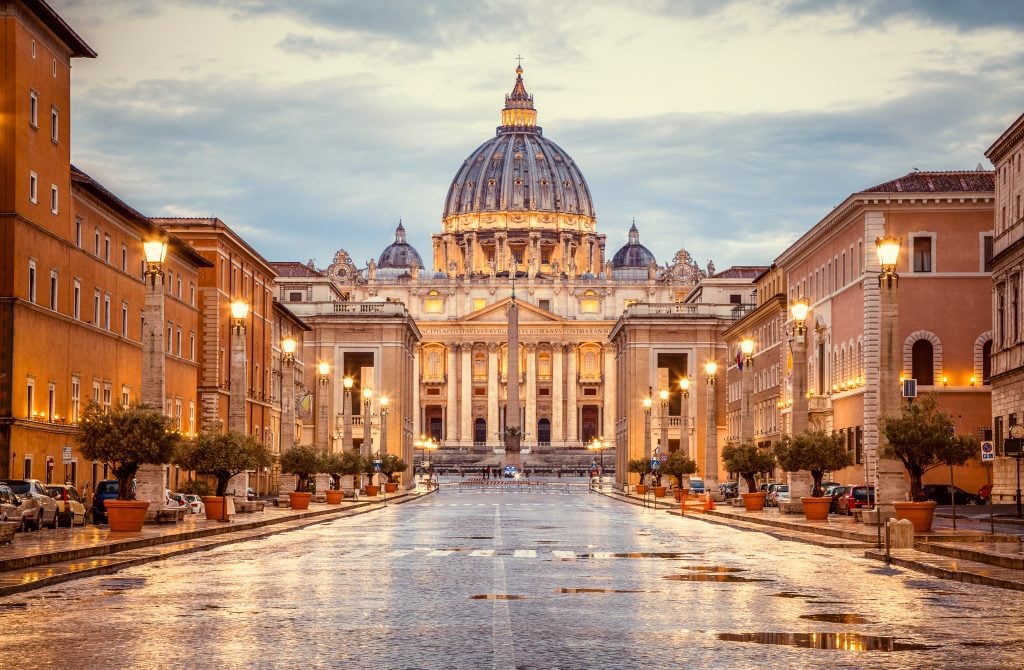
Vatican City
Submitted by Nausheen of Globe Gazers
One of the ultimate Italy landmarks to visit in your lifetime is Vatican City. The smallest country in the world, Vatican City is an independent city-state surrounded by Rome and the seat of the Roman Catholic Church. Only the clergy and Swiss guards who protect the Vatican City are allowed to live there.
Key points of interest within Vatican City are the Vatican Museums (home to Michelangelo’s Sistine Chapel) and St. Peter’s Basilica. Vatican City is overflowing with religious and artistic significance, so the recommended way to experience it is with a guided tour (this one includes all the major sites).
Be sure to check out some of the 17 best Vatican tours to help you design your visit. In addition to visiting the Vatican Museums and St. Peter’s Basilica, you can even attend a papal audience for a chance to see the Pope in person. No matter your religion, a visit to Vatican City is a worthwhile addition to any Italy bucket list.
Be sure to follow the dress code — both men and women should have their knees and shoulders covered. Opt for long pants, skirts or dresses and sleeved tops rather than sleeveless.
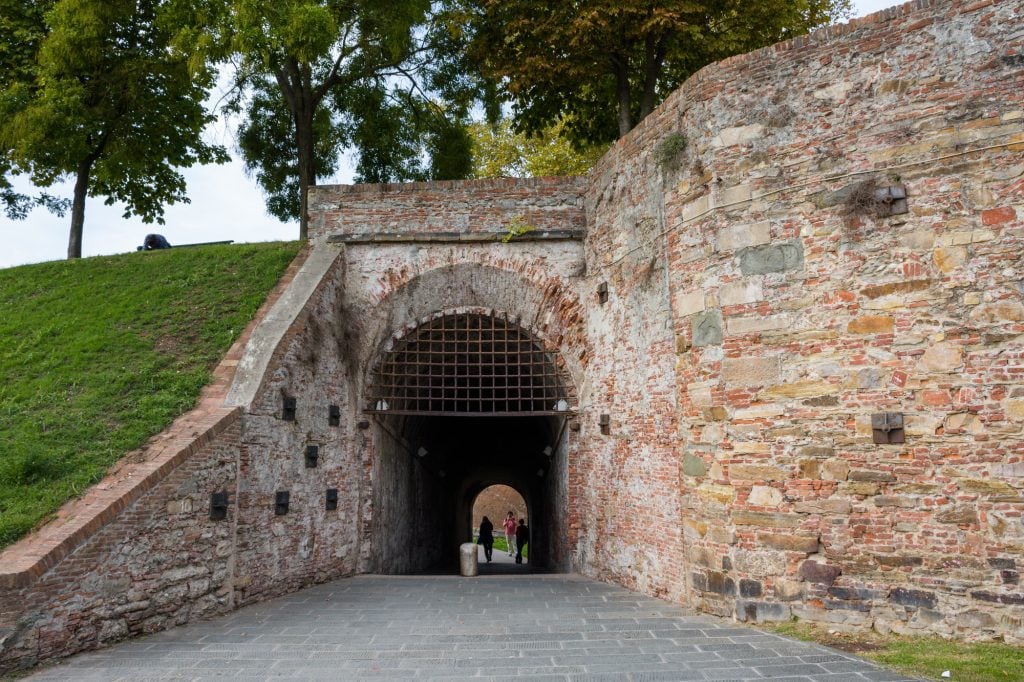
Lucca City Walls
Submitted by Ali from Berlin Travel Tips
The town of Lucca in Tuscany is well worth visiting for many reasons, but the old city walls are the main attraction here. Like most cities in Europe, Lucca had fortified walls built around the city for protection.
But the walls you see today have been rebuilt several times. Romans actually built walls here more than 2,000 years ago, a second set of walls was built here in the Middle Ages, another set in the end of the 1500s, and then they were rebuilt yet again from the mid 1600s to early 1800s.
While many cities have pieces of their old walls, Lucca’s city walls are one of the largest examples of intact city walls still standing in Europe. You can enjoy this Italian landmark by walking along the top of the walls or from the lawns below outside the walls. It’s also worth exploring Lucca’s old town, including two different towers you can climb for views of the city and its surrounding walls.
Visiting Lucca feels like going back in time with its gorgeous streets and old-world atmosphere. It’s only 1 hour and 20 minutes away from Florence by train, so it’s easy to visit as a day trip from Florence, but it’s also quite enjoyable if you decide to spend the night.
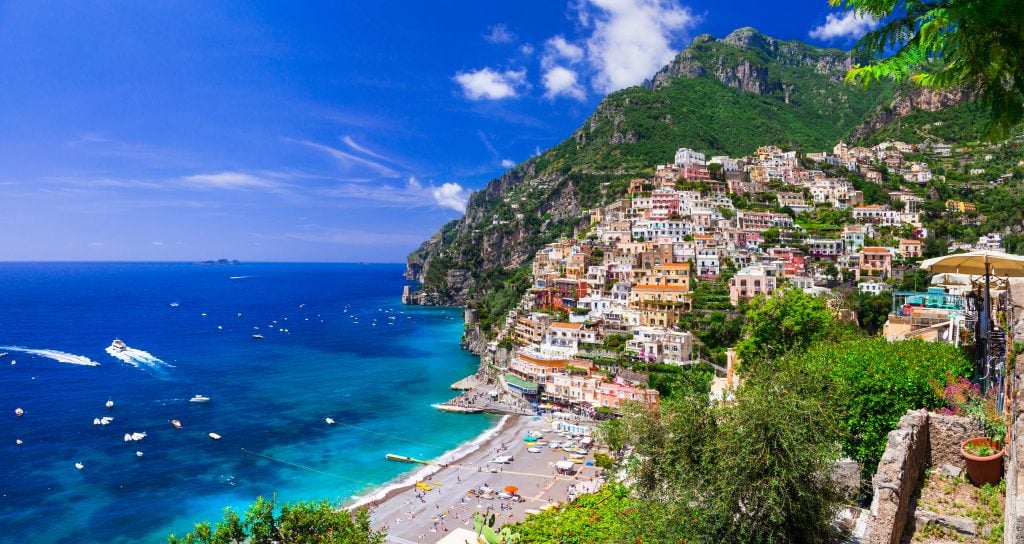
Amalfi Coast
Submitted by Isabella of Boundless Roads
If you are traveling to Southern Italy, one of the most spectacular Italian landmarks is the Amalfi coast — or Costa Amalfitana.
Located in the Italian Region of Campania, south of Naples, the Amalfi Coast is the 50 kilometers of coastline that stretches from the towns of Positano to Vietri Sul Mare.
Along the rugged coast, you will find several cute towns perched on the surrounding hills with spectacularly breathtaking views.
The best way to travel along the Amalfi coast is by car because you will want to stop at every viewpoint and enjoy the incredible postcard-worthy sights, and you wouldn’t be able to do it if you take the bus.
Also, you should keep in mind that the road from Naples to the Amalfi coast is also packed with interesting sites, such as the archeological sites of Ercolano (Herculaneum) and Pompeii, as well as the pretty town of Sorrento, which makes a great base for exploring this region.
The prettiest and most popular town on the Amalfi Coast is Positano, so if you’re in a rush, make sure you don’t miss it, although the towns of Amalfi and Atrani are quite beautiful as well.
The best time to visit the Amalfi Coast is May, June, or October. These months have wonderfully pleasant weather (you can even swim in June or October) and while fairly busy, aren’t as packed as the peak months.
July, August, and even September these days are becoming the most popular months of the year to visit the Amalfi Coast, when crowds are heaving and prices are sky-high. Know that if you visit in the winter, it will be cold and almost everything will be closed, though if you’re just here for the photos and atmosphere, you might enjoy it.
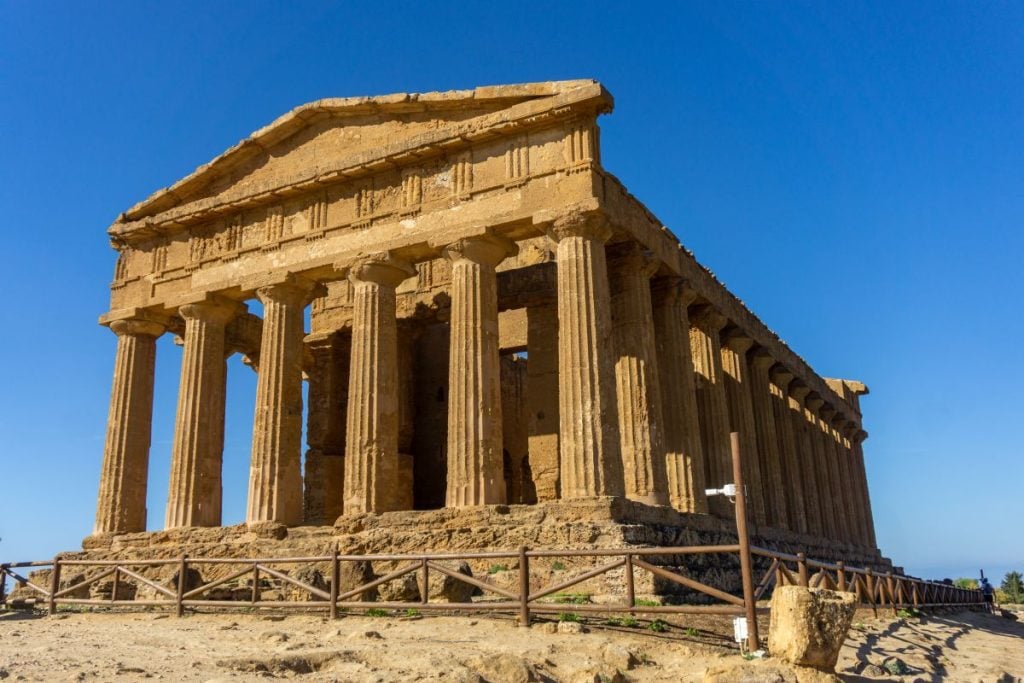
Valley of the Temples, Sicily
Submitted by Maggie of The World Was Here First
One of the top attractions on the island of Sicily is, without a doubt, the incredible Valley of the Temples just outside of the town of Agrigento. Located in the south of Sicily, the site is easily reached from both Palermo and Catania, making it easy to spend a day in Agrigento.
The Valley of the Temples is a UNESCO World Heritage Site consisting of well-preserved Greek temples dating back to the 5th Century BCE. As one of the largest archaeological sites in Sicily, plan to spend at least a couple of hours taking in the incredible temples here.
The most impressive temple in the park is the incredible Temple of Concordia, one of the best-preserved temples in the world. Still mostly intact after thousands of years, you can even see this beautiful ancient structure from the highway.
Other temples in the archaeological park include the beautiful Temple of Heracles, the Temple of Juno, and the Temple of Dioscuri. You can also opt to visit the Regional Museum of Archaeology while in the park, should you wish.
If you’re planning a trip to Sicily and want to be whisked back to ancient times, you absolutely cannot miss the Valley of the Temples near Agrigento.
Read More: The Joys and Challenges of Traveling in Sicily
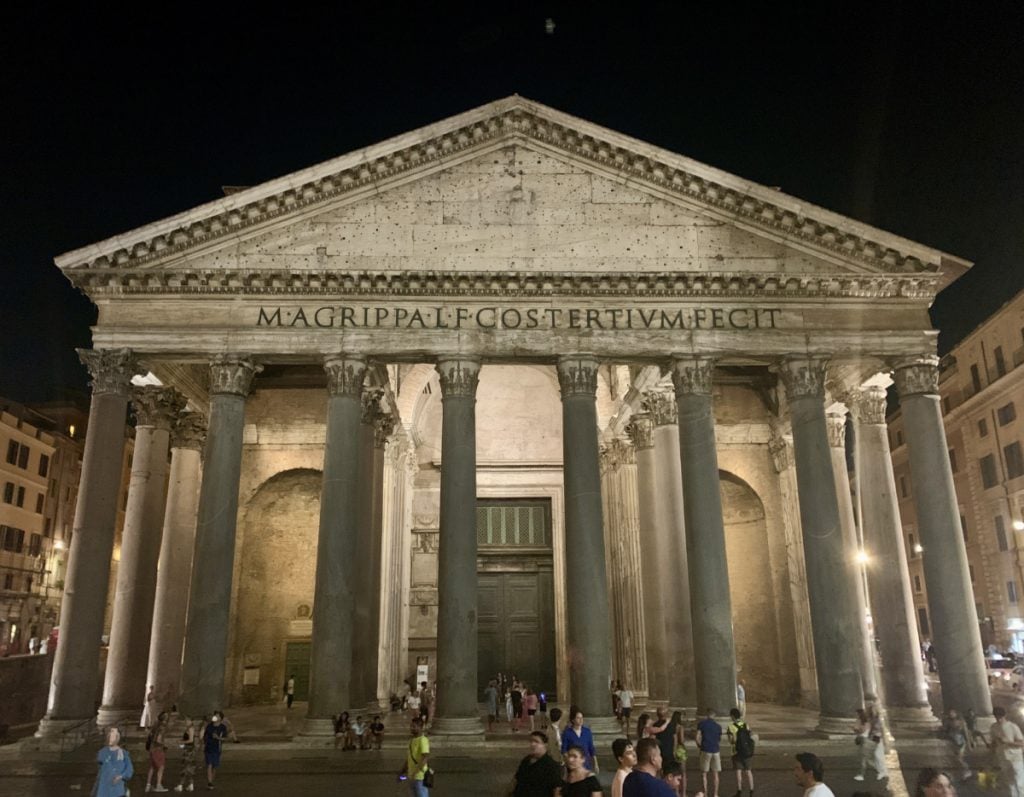
Pantheon
Submitted by Deanne of Scenic and Savvy
The Pantheon in Rome is a must-see landmark while visiting Italy. Known for its impressive size, architectural design, and rich history, the Pantheon began as a pagan temple but now serves as a Christian church. The current structure, built around 126 ACE, is the best preserved building from ancient Rome.
The exterior of this architectural wonder includes 16 giant Egyptian-granite columns with marble bases surrounding the portico. Inside the building, the world’s largest unsupported concrete dome — stretching 142 feet in diameter — comes into view.
The center of the coffered dome contains a large opening, or oculus, which lets sunlight flood through (and occasionally rainfall, too).
It’s believed that when Michelangelo saw the Pantheon for the first time, he said it looked more like the work of angels, not humans. The Pantheon houses an impressive collection of paintings, sculptures, and tombs, including the final resting place of the famed artist, Raphael.
Located right in the heart of Rome between Piazza Navona and Trevi Fountain, the Pantheon is easy to fit into even a short Rome itinerary. There is no fee to enter the church, but there is a dress code — shoulders and knees must be covered, and hats are not allowed.
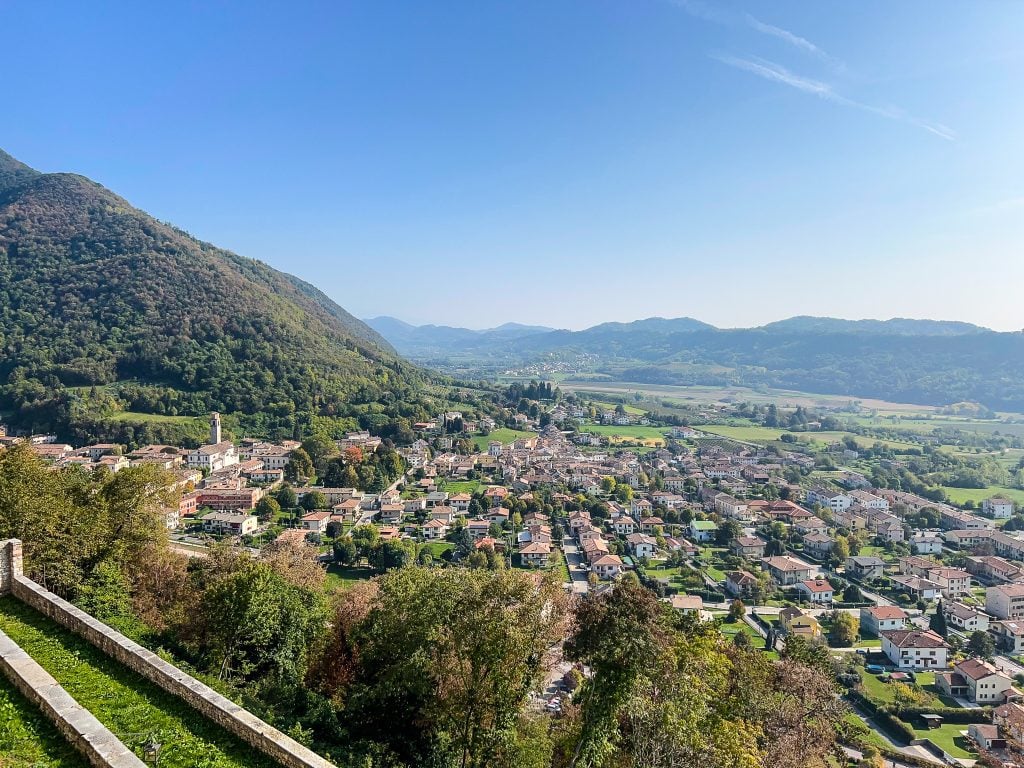
Prosecco Hills
Submitted by Lyndsay from The Purposely Lost
Located just north of Venice, the Prosecco Hills of the Veneto region of Italy are a UNESCO World Heritage Site and one of the most incredible Italy landmarks, especially for wine fans!
With its stunning views of rolling hills, vineyards, and quaint villages, the area is known for producing the world-famous Italian sparkling wine Prosecco.
While only nine provinces within the regions of Friuli-Venezia Giulia and the Veneto have the ability to produce this wine varietal, the hills between the towns of Conegliano and Valdobbiadene form the protected area and receive the distinguished D.O.C.G. (designation of controlled and guaranteed origin) label.
A visit to the Prosecco Hills is a must for any traveler looking to experience the beauty of northern Italy — with a side of bubbly!
On a vineyard tour, you’ll learn about this delicious sparkling wine’s history and production process and get to sample some of the best Prosecco in Italy and other local wines.
If you’re already planning a trip to Venice, it’s easy to add a Prosecco tour from Venice since many pick you up right from the city center. Otherwise, you can take the train to Conegliano and hire a car service or use a local taxi to visit the vineyards.
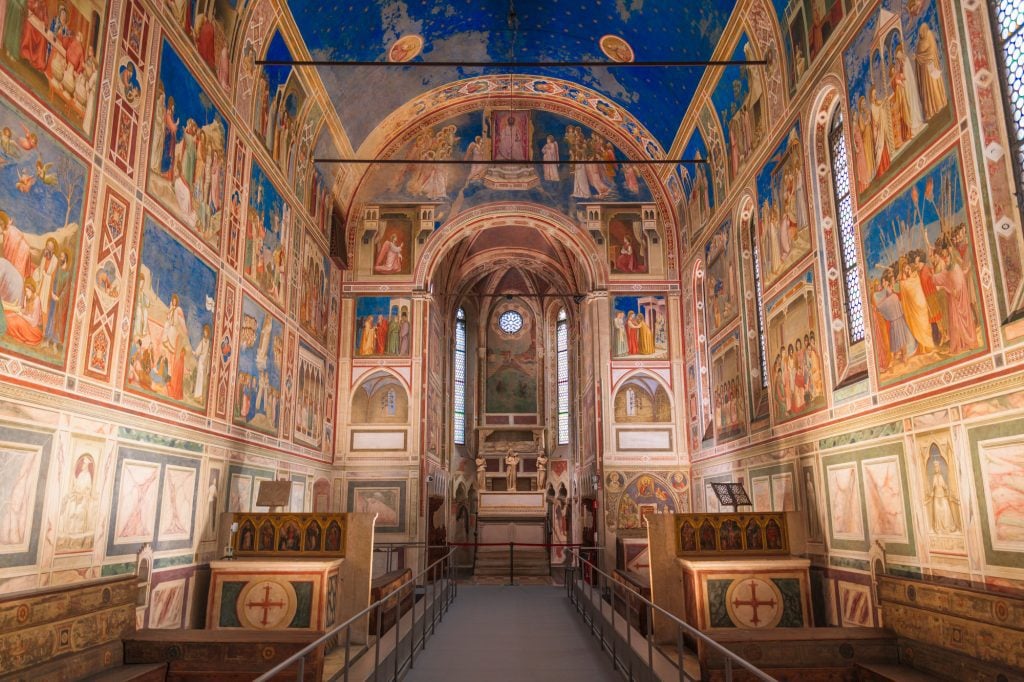
Scrovegni Chapel
Submitted by Daniela of Ipanema Travels
It took a while until the Scrovegni Chapel in Padua (Padova) was recognized as a UNESCO World Heritage Site, but it finally happened in 2021. Together with seven other amazing masterpieces, the Scrovegni Chapel was added to the family of World Heritage Sites as a part of Padua’s fourteenth-century fresco cycles, as one of Italy’s best landmarks.
Modest from the outside, the chapel’s treasure lies inside. Frescoed between 1303 and 1305 by no other than Giotto, the Scrovegni Chapel is considered as the cradle of the Renaissance in Italy.
Giotto’s art in this chapel laid the foundations of a phenomenon that would be further picked up by Michelangelo and Masaccio and would change the perception of perspective and color for good. It would also break off with the religious canon and open the doors for freedom of thought and expression.
Giotto’s frescoes in the Scrovegni Chapel are simply mesmerizing. Look at the expression of the faces and the masterful use of color and perspective.
Before visiting the Scrovegni Chapel, one of the most famous attractions in Padua, you need to prepare in advance. You have to book your time slot in advance; same day entry tickets are not possible.
When there, be prepared to first wait in an antechamber with climate control for a good 10 minutes before you enter the small chapel. Visits to the chapel itself are limited to about 15–20 minutes. All this makes you realize how vulnerable art is and what it takes to preserve it.
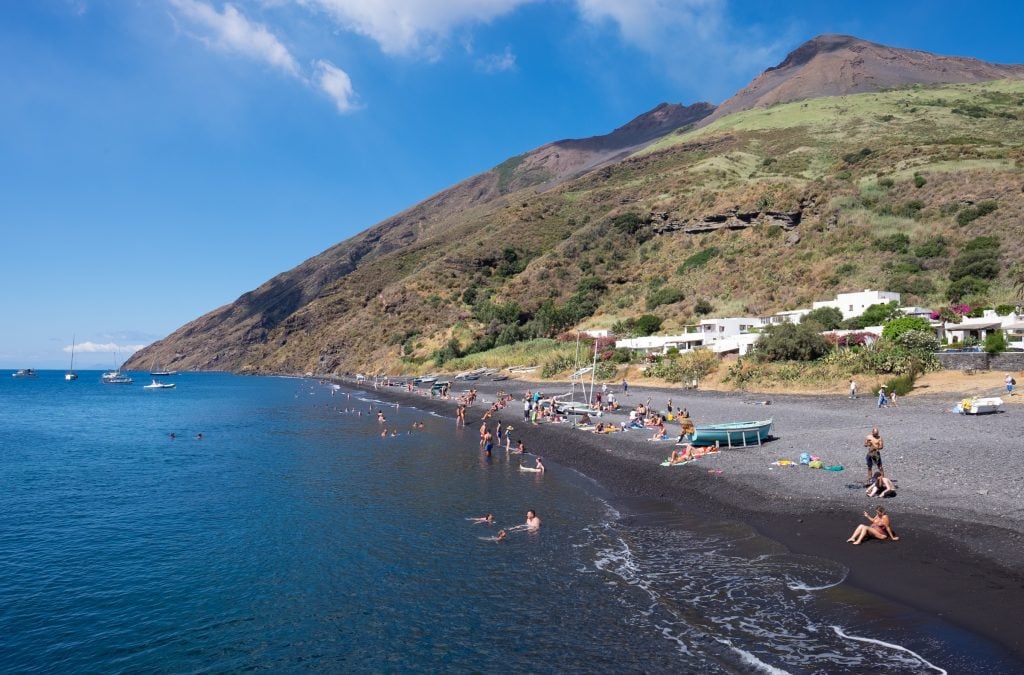
Aeolian Islands
The Aeolian Islands are an archipelago off the northeast edge of Sicily, close to Milazzo. The islands received their UNESCO World Heritage designation for their natural heritage: they were constructed by volcanic activity, resulting in a wildly dazzling landscape.
There are seven Aeolian Islands, and each has their own personality. Vulcano has the best views in the archipelago; Alicudi is remote with donkeys for transportation; Panarea is where the ultra-rich love to get away.
But two islands are the best places to base: Salina, with gorgeous villages, capers growing wild, low-key roads, and excellent boutique hotels (like my all-time favorite, Hotel Ravesi).
And then there’s Stromboli — an island with an active volcano that erupts continuously! For the ultimate Aeolian adventure, climb Stromboli to see the lava eruptions up close — or watch from a nearby boat or Osservatorio pizza restaurant on the edge of the volcano.
Between volcanic hikes, black sand beaches, island journeys by Vespa, and big plates of pane cunzatu, the Aeolians are a perfect summer getaway and a truly remarkable Italy landmark.
Read More: Complete Guide to the Aeolian Islands, Sicily
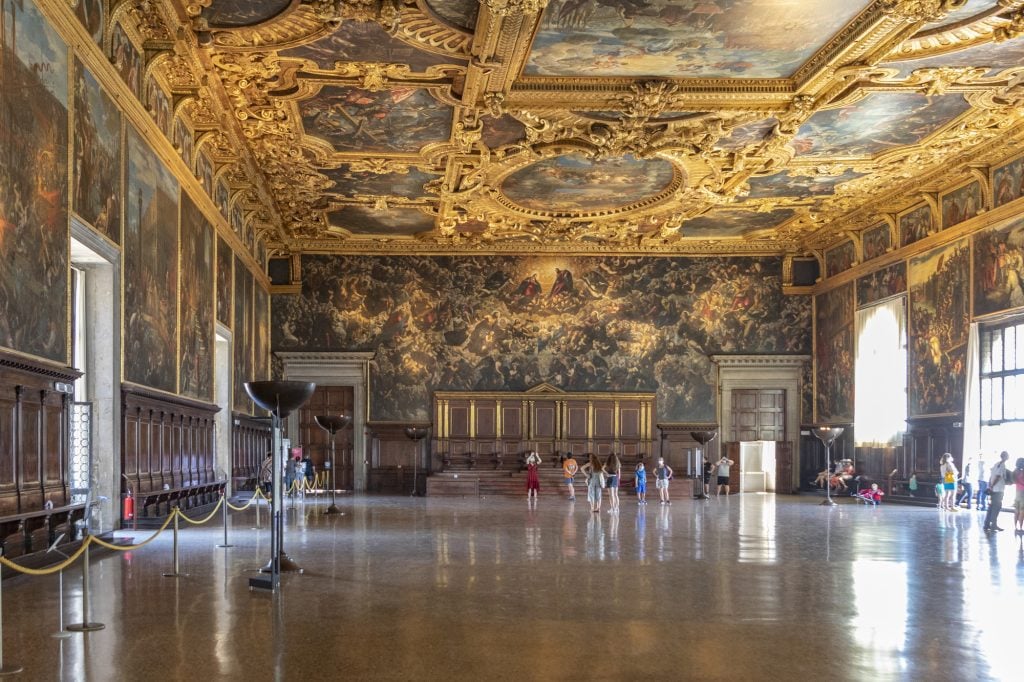
Doge’s Palace
Submitted by Maggie of Pink Caddy Travelogue
One of Italy’s must-see landmarks is Venice’s opulent Doge’s Palace. Once upon a time, Venice was its own powerful, commercially successful republic; by the end of the 13th century, it was one of Europe’s wealthiest cities.
Built for the Doge, Venice’s supreme authority, the palace exemplifies Venice’s wealth, power, and love for the arts. While primarily a place for business (along with the doge’s private quarter, it also housed a prison, court facilities, and Venice’s Senate), the Venetians spared no expense on its construction. Today, tourists flock to the palace to see its fabulously ornamented interior rooms and flawless architecture.
Among the highlights of a visit to the Doge’s Palace is the Golden Staircase, so called for its white and gold stucco decoration, which leads to the doge’s chambers. The Great Council Hall is where Venice’s legislative body once met. The hall is covered in paintings — 35 panels are on the ceiling alone, and one of those is Tintoretto’s Il Paradiso, the largest oil painting in the world.
One of the most famous bridges in the world is part of the palace, the Bridge of Sighs. It was added in 1600 to connect the palace courts to the prison on the other side of the canal.
The Doge’s Palace is a sprawling site filled with incredible architecture and artwork. It’s no wonder it’s one of the most famous Italy landmarks. It’s worth a visit, even if you only have one day in Venice.
You can book tickets that include both Doge’s Palace and Basilica San Marco.
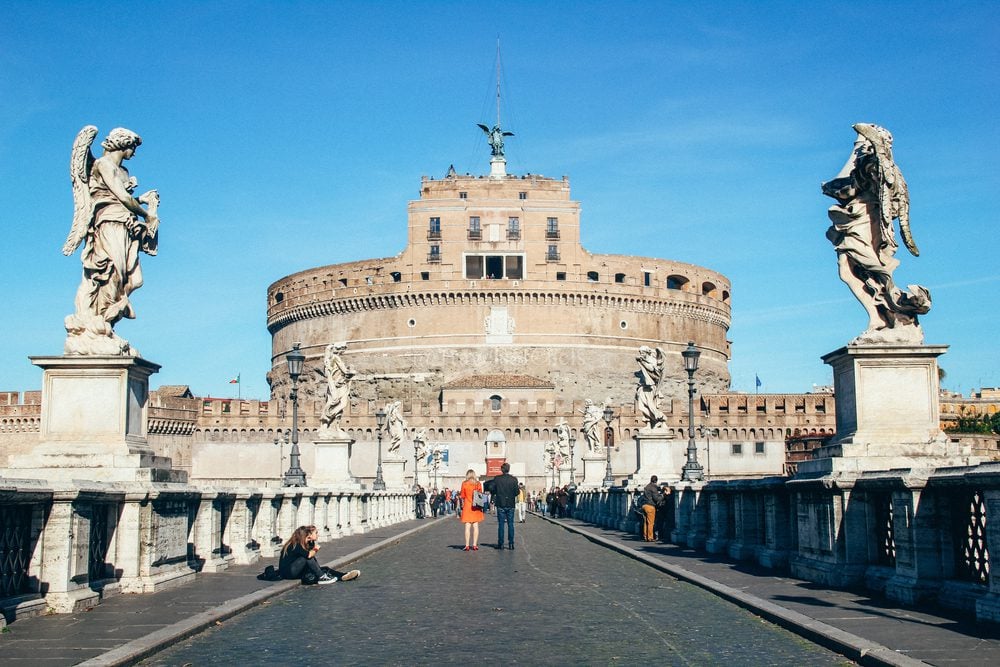
Castel Sant’Angelo
Submitted by Chelsea of Adventures of Chels
An Italian landmark you should visit at least once in your lifetime is Castel Sant’Angelo in Rome, built sometime between 134 and 139 ACE. It was originally intended to be a mausoleum for Hadrian and his family. His and his family’s remains, along with the remains of emperors who came after him, were kept here.
Starting in the 14th century, popes converted the mausoleum into a castle. An underground path that connects the Vatican to the castle was created to give the pope a safe place to escape to when necessary.
Today Castel Sant’Angelo is a museum. Visitors usually spend 1-2 hours inside. Note that on the seventh floor of the castle is a terrace with a wonderful view of the Vatican and Rome. If possible, visit during sunset as the soft light reflects beautifully on the surrounding buildings and river.
Be sure to also visit the best spots to take photos of Castel Sant’Angelo itself: Ponte Sant’Angelo, the bridge leading to the castle, and Via della Conciliazione, the street that connects the castle to the Vatican.
Enjoy your time in Rome and your visit to the beautiful Castel Sant’Angelo!
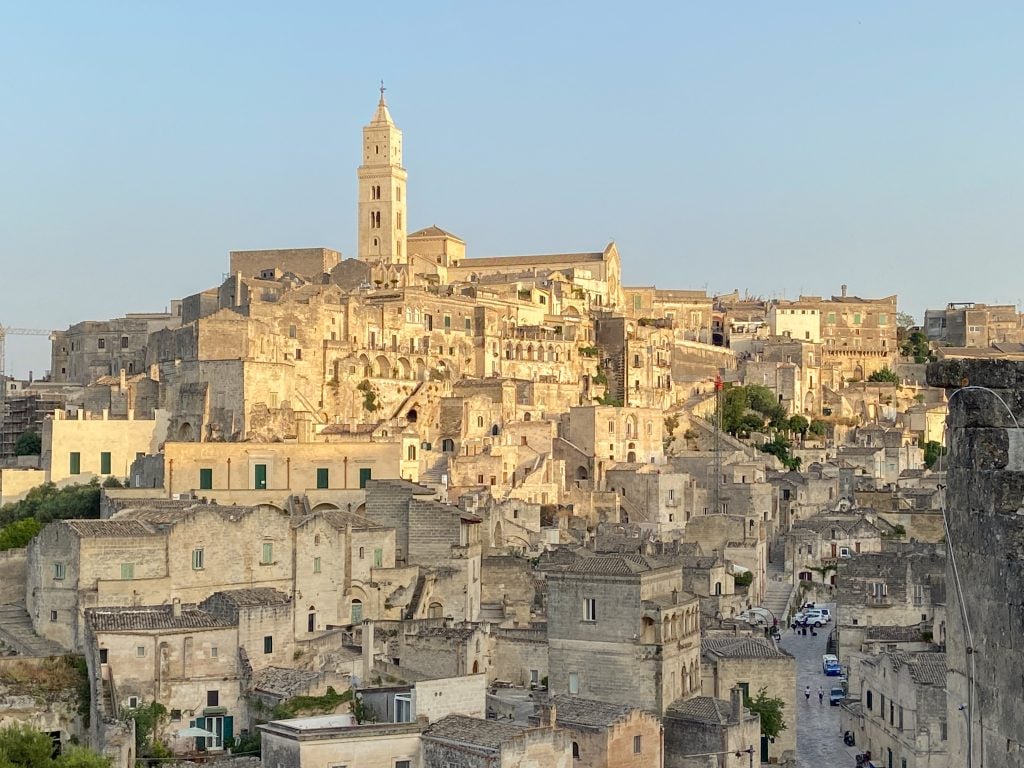
Sassi di Matera
Submitted by Megan of Megan Starr
The Sassi di Matera are located in one of the world’s most fascinating ancient towns and has been continuously inhabited for 9,000 years. Matera is known for its old cave dwellings carved into limestone cliffs.
Despite being inhabited for thousands of years, in the 1950s the Italian government forcefully relocated residents out of the old caves to the upper part of the more modern town, due to disease and poor conditions in the cave system.
Several decades later, the revitalization and restoration of the Sassi started, turning the caves back into homes and creating hotels and restaurants. In 1993, it was declared a UNESCO World Heritage Site for its fascinating history dating to the Palaeolithic period.
While visiting, make the Casa Noha Museum your first stop, as it is one of the best things to do in Matera. You’ll learn more about the caves and the unique history of the town. To get a taste of what life was like long ago, check out the Casa Grotta di Vico Solitario, a reconstruction of an 18th-century cave house.
Don’t miss the beautiful Park of the Rupestrian Churches, which are ornate churches built into the cliffside and also under UNESCO World Heritage designation. You also might recognize the town of Matera if you’ve seen the James Bond film No Time to Die or The Passion of the Christ, as Matera is a popular filming location for its old-world look.
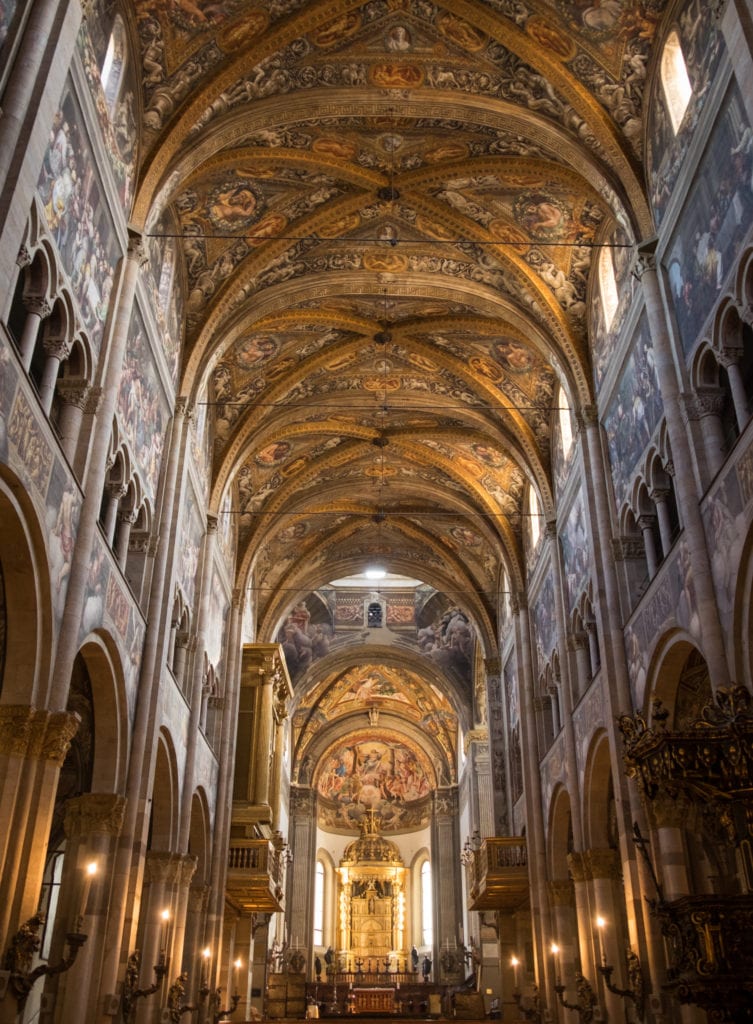
Parma Cathedral
On most trips to Italy, you’ll be visiting a LOT of cathedrals. But there’s one you shouldn’t miss — the Cathedral of Parma (Cattedrale di Santa Maria Assunta), one of the best Italy landmarks in the region of Emilia-Romagna.
Parma, Italy is a colorful city with fabulous street life, outstanding shopping, and some of the best food in Italy. But even in the heart of an impressive city like that, the cathedral will hush you when you walk in.
Parma’s cathedral was originally built in the 11th century (quite old by Italian standards!). The interior doesn’t leave a square inch uncovered. Everything is filled with ostentatious religious art and Baroque architecture, all warm colors and shining gold.
Don’t miss Antonio da Correggio’s painting of the Assumption of the Virgin on the cupola, which uses perspective as an optical illusion, painting his vision of what it means to ascend to heaven.
You can also visit the nearby Baptistery for more gorgeous paintings on the ceiling.
Read More: Ultimate Guide to Parma, Italy
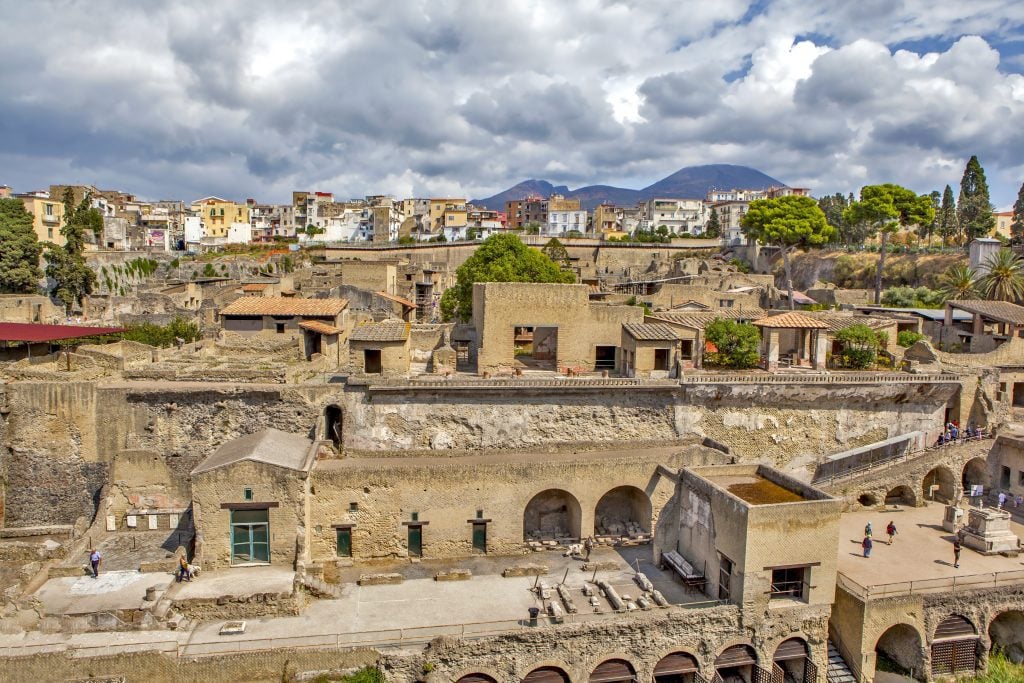
Herculaneum
Submitted by Sam from My Flying Leap
When Mount Vesuvius erupted in 79 CE, Pompeii wasn’t the only thriving town destroyed — nearby Herculaneum also didn’t survive the disaster. Both are part of a UNESCO World Heritage Site, sharing a prized glimpse into the past.
Though Herculaneum isn’t as well-known, it’s actually better preserved than Pompeii. It was hidden for over a thousand years and not looted to the extent Pompeii was, sharing an incredible glimpse of what life once was like here.
Herculaneum was a residential city on the water where the wealthy once lived. The city was so well preserved under over 20 feet of ash and pyroclastic flow that you can actually see mosaics on the floor and murals on the wall. The second floor of many structures remains and you can actually see the wood that was petrified in the doorways.
A small part of Herculaneum has been excavated as it’s located underneath the city of Ercolano. What you can see when you visit are the private homes of its wealthy occupants. Most of the public buildings, similar to what you can see in Pompeii, are not uncovered.
If you want to see the treasures found inside Herculaneum, visit the Naples National Archaeological Museum. The onsite Herculaneum Museum gives you a great glimpse into what you can expect to see.
Herculaneum is a real treasure worth seeing, especially with an expert tour guide. Don’t miss Pompeii, of course, which is impressive for its size. But Herculaneum is the real jewel not to miss.
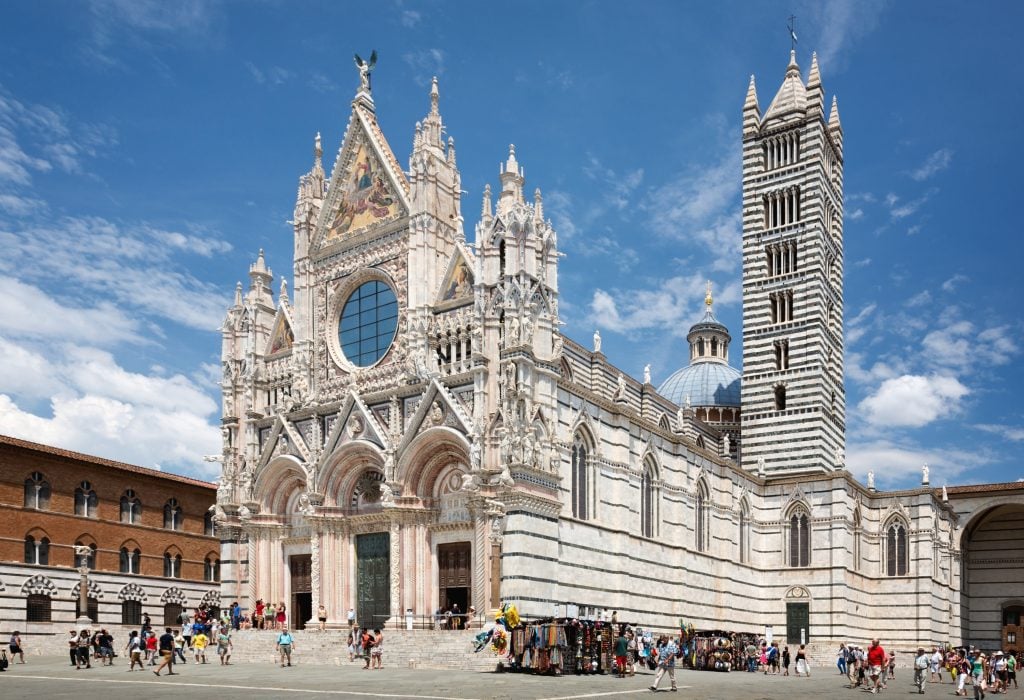
Siena Cathedral
Submitted by Milijana of World Travel Connector
Siena Cathedral is one of the most beautiful cathedrals in Tuscany and a justifiably famous landmark in Italy. This cathedral is famed for its architectural beauty and the outstanding collection of masterpiece artwork from sculptures to paintings, stained glass, frescoes, bas-reliefs, and mosaics, as well as the Piccolomini Library, home to Pinturicchio’s frescoes.
Many famous artists worked at Duomo di Siena, like Donatello, the father and son Pisano, Bernini, Pinturicchio, and Raphael.
Siena Cathedral is among the prettiest Romanesque and Gothic cathedrals in Italy, with alternating stripes of black and white marble and a unique graffito floor. Black and white are the symbolic colors of Siena.
The medieval Republic of Siena was a powerful and wealthy independent state, a medieval commercial and banking center, and a rival to the neighboring medieval Republic of Florence. Siena Cathedral was a symbol of power and architectural and artistic rival to the Duomo of Florence.
The Siena Cathedral complex covers the Duomo, the library, the baptistery, the crypt in the basement, and the cathedral museum of Siena. The complex is a must-see when you travel to Tuscany, Italy. In fact, the Historic Centre of Siena, with the marvelous Piazza del Campo, is yet another UNESCO World Heritage Site in Italy.
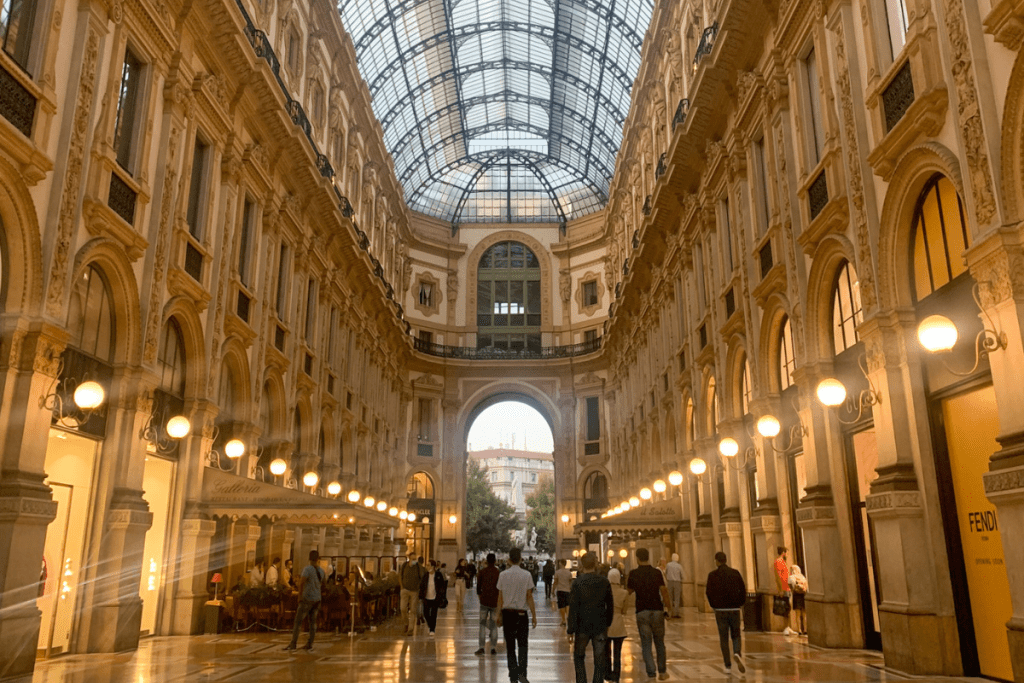
Galleria Vittorio Emanuele II, Milan
Submitted by Kristin of Global Travel Escapades
An absolute must-visit landmark located in Northern Italy is the Galleria Vittorio Emanuele II. The famous shopping mall is located in Milan and is the oldest active shopping gallery in all of Italy.
Even if you aren’t one for shopping at luxury stores, getting to witness the building’s intricate architecture is reason enough to walk around! At the center of the gallery, you’ll be able to observe what was once the largest glass and cast-iron dome. And beneath the dome, you’ll find beautiful mosaic patterns illustrating the coat of arms of four of Italy’s major cities.
Within the gallery, visitors will discover all kinds of luxury brand stores including, Fendi, Prada, and Louis Vuitton. It’s nothing short of paradise for anyone who’s a shopaholic! In fact, the abundance of high-end designer stores is part of the reason Milan is often compared to Paris as the fashion capital of Europe!
Plus, the gallery isn’t too far from Piazza del Duomo. So, when you’re done wandering through, you can easily check out the impressive Milan Duomo! Ultimately, whether you fancy a bit of shopping or simply want to take in the views, make sure you spend some time inside Galleria Vittorio Emanuele II on your trip to Milan.
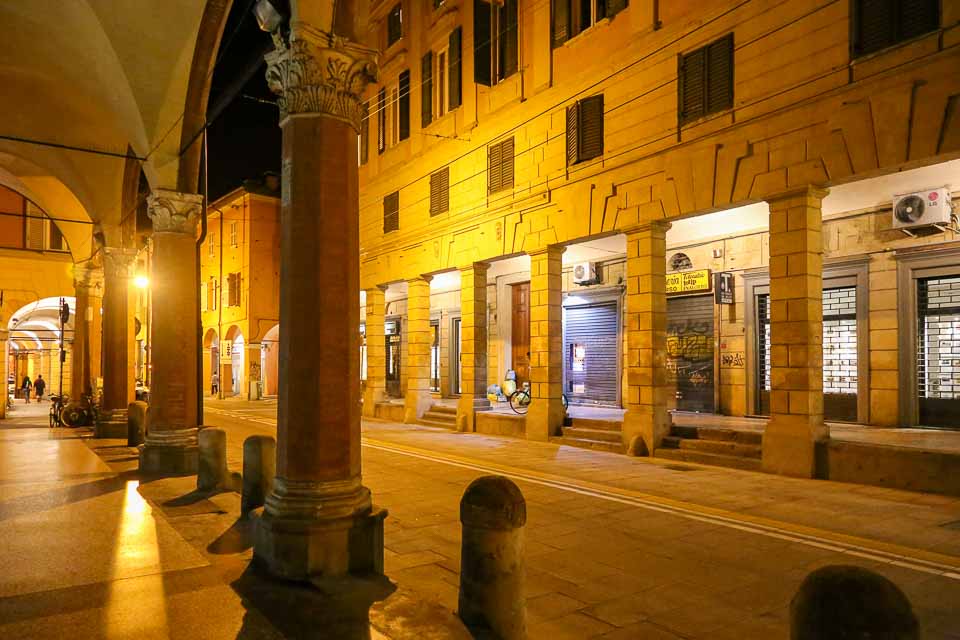
Porticoes of Bologna
Submitted by Lori of TravlinMad
For many, a trip to Italy is a once-in-a-lifetime experience with countless renowned landmarks to visit. One historic site that should be at the top of your bucket list is the beautiful covered porticoes of Bologna. They stretch for 27 miles around the city and were an architectural marvel when constructed.
Designated a UNESCO World Heritage Site in 2021, they date back to the 11th century. It is believed that the porticos were built to increase the floor space on the upper floors of a building instead of expanding the first floor, which would have resulted in higher taxes for the owner.
These ingenious columns are all unique and breathtaking to see, especially at night when the city is quiet and the lighting under the eaves has a soft golden glow.
But the porticoes stretching throughout the city are also functional, and allow you to visit Bologna any time of year, in any weather. Strolling them is one of the best things to do in Bologna, a city known for its food. And you can enjoy it all without ever leaving their cover, from lively osterias to the ubiquitous espresso and gelato shops.
In some areas, the porticoes are so colorful and ornate, with elaborate designs painted on the ceilings. Underfoot, the flooring is either beautiful tiles or terrazzo. Amazingly, the Portico di San Luca — one of the most famous porticoes — stretches to the Sanctuary of San Luca, overlooking the city more than three miles away.
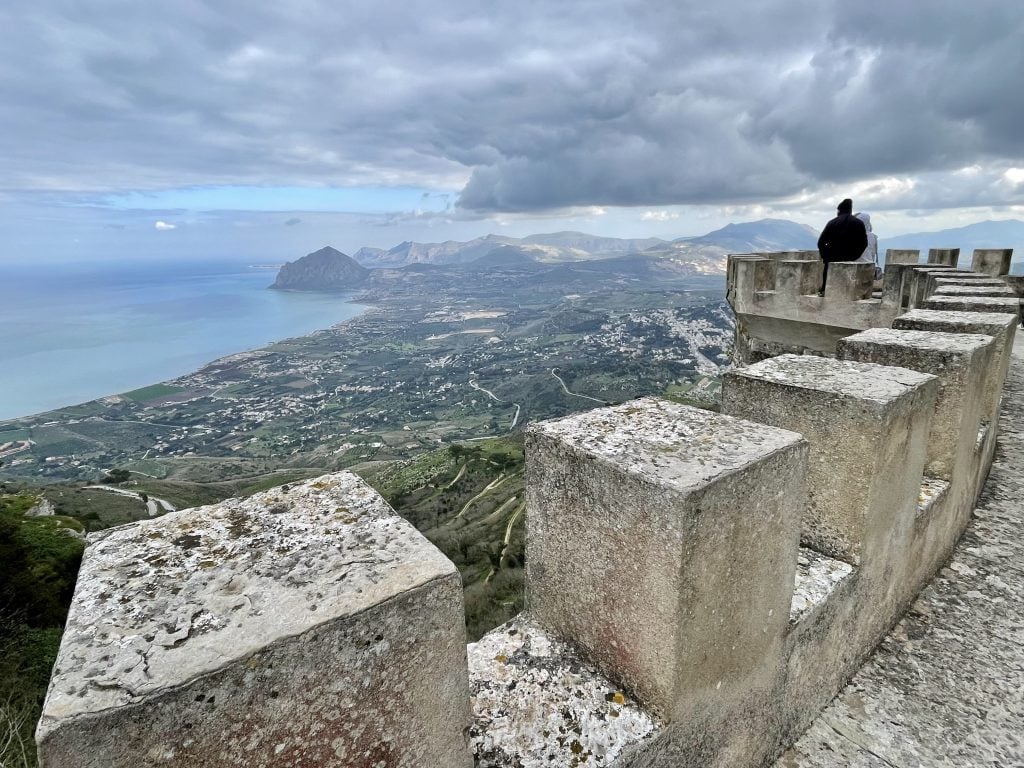
Erice
Submitted by Becki of Meet Me In Departures
The medieval hill town of Erice is located in the west of Sicily and sits about 750 meters (2,460 ft) above sea level. It looks down on the salt flats of Trapani and the surrounding landscapes of Punta del Saraceno and San Vito Lo Capo. On a clear day, you can even see the Egadi Islands.
There are a few ways to get to Erice. If you’re feeling energetic you can hike or cycle up Mount Erice, though know this is a massive undertaking! If you have your own transport, then drive the winding path up. However, the most exciting way to get there is via cable car from Trapani.
Once at the top, you’ll find that nearly all year round the town is enveloped in a thin layer of cloud. These misty clouds are known locally as the kisses of Venus.
It’s easy to whittle a whole day away here exploring the ancient and photogenic cobblestone alleyways. For the best views, head to the Garden of Balio and the upstairs level in the Church and Convent of San Domenico.
If you’re in Erice later in the day, it’s a great vantage point to see some of the most beautiful sunsets on the island.
If you don’t have transportation of your own, consider a tour of Erice, Segesta, and the Trapani salt flats from Palermo.
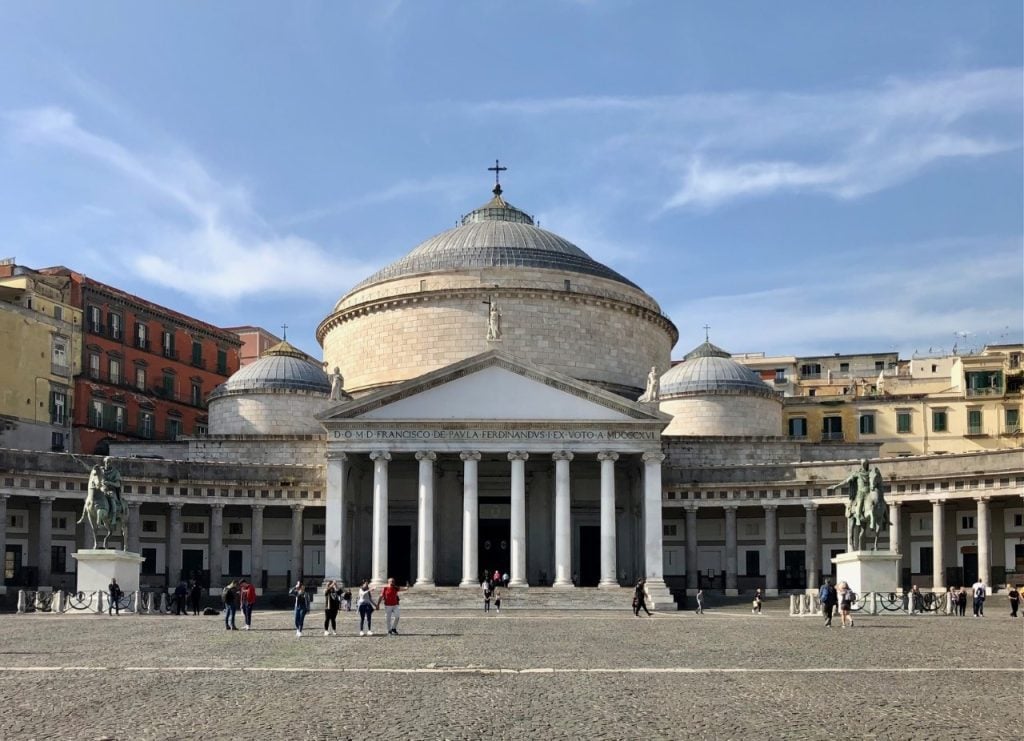
Piazza del Plebiscito
Submitted by Lisa from Waves and Cobblestones
The Piazza del Plebiscito, located in the historic center of Naples, is one of the top landmarks in Italy. This piazza is the largest in Naples and is surrounded by many of the most famous attractions in Naples. In fact, the entire historic center of Naples is recognized as a UNESCO World Heritage Site due to its impressive number of well-preserved monuments.
The Piazza del Plebiscito is built out of volcanic rock from Mount Vesuvius. This immense piazza is a pedestrian-only zone and is used for civic events and open-air concerts. The piazza features equestrian statues of Ferdinando I and Carlo III. The piazza is especially popular as a meeting point and is a great place from which to begin exploring Naples.
On the eastern side of the Piazza del Plebiscito, you’ll find the magnificent Royal Palace of Naples. Tour this restored palace and admire the ornate period furnishings and incredible works of art. You can tour the courtyard and gardens of the palace for free!
On the western side of the piazza is the stunning San Francesco di Paolo Basilica. This basilica features classical columns reminiscent of a Greek temple, with graceful colonnaded wings arcing out from the basilica. Inside, marvel at the art and statuary, and be sure to look upwards to view the geometric patterns and skylight in the domes.
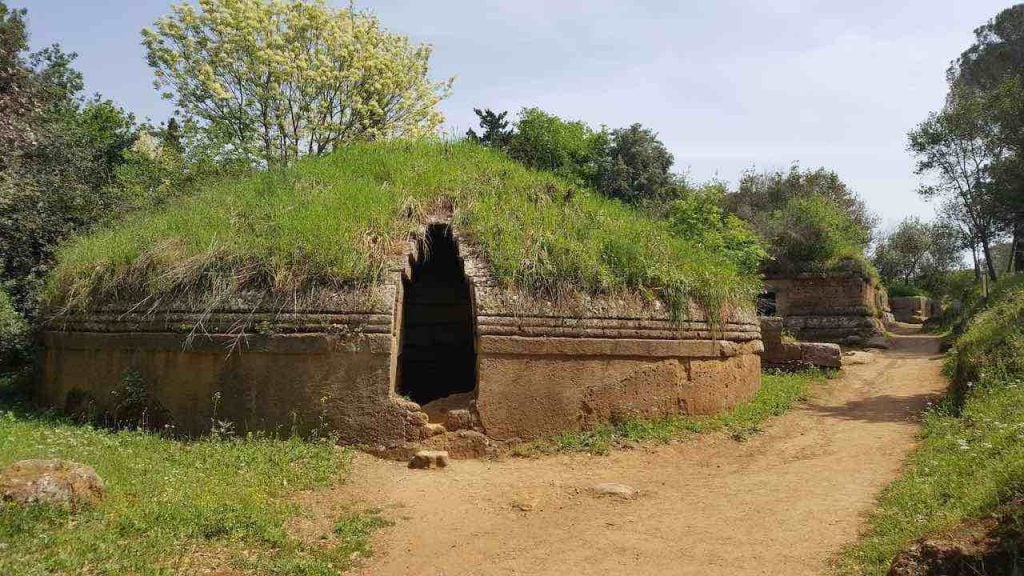
Etruscan Necropolises
Submitted by Lisa of Travel Connect Experience
The Etruscan Necropolises of Tarquinia and Cerveteri, located in the Lazio region of Italy, are the main evidence of the Etruscan civilization. Since 2004, these archaeological sites have been UNESCO World Heritage Sites.
The Etruscan civilization flourished in Central Italy between the 9th and 3rd centuries BCE and eventually fell to the Romans, following a long war. In fact, the Romans inherited architectural techniques, hydraulic engineering and religious cults, among other things, from the Etruscans!
The Necropolis of Cerveteri is located about 50 kilometers from Rome and is notable for its architecture. It is a true “city of the dead” that replicates the cities of the living.
The tombs of aristocratic families are large mounds with one or more rooms where rich grave goods were found. The tombs of the people are excavated along a pathway that opens into a tufa wall, called the “Way of the Underworld.”
Etruscan tombs contain stone-carved beds and columns. One of the most outstanding finds is the “Sarcophagus of the Spouses” from the 6th century BCE. The painted terracotta sarcophagus shows a married couple lying on a typical “convivial bed” in the act of participating in a banquet.
The Etruscan Necropolis of Tarquinia is located 50 km west of Viterbo and is especially known for its painted tombs. The wall paintings depict the daily life of the Etruscans and are the greatest testimony on the customs of these people.
Finds from the sites of the two necropolises are displayed in the most important museums in Italy, including the National Archaeological Museum in Tarquinia and the Etruscan Museum in Rome.
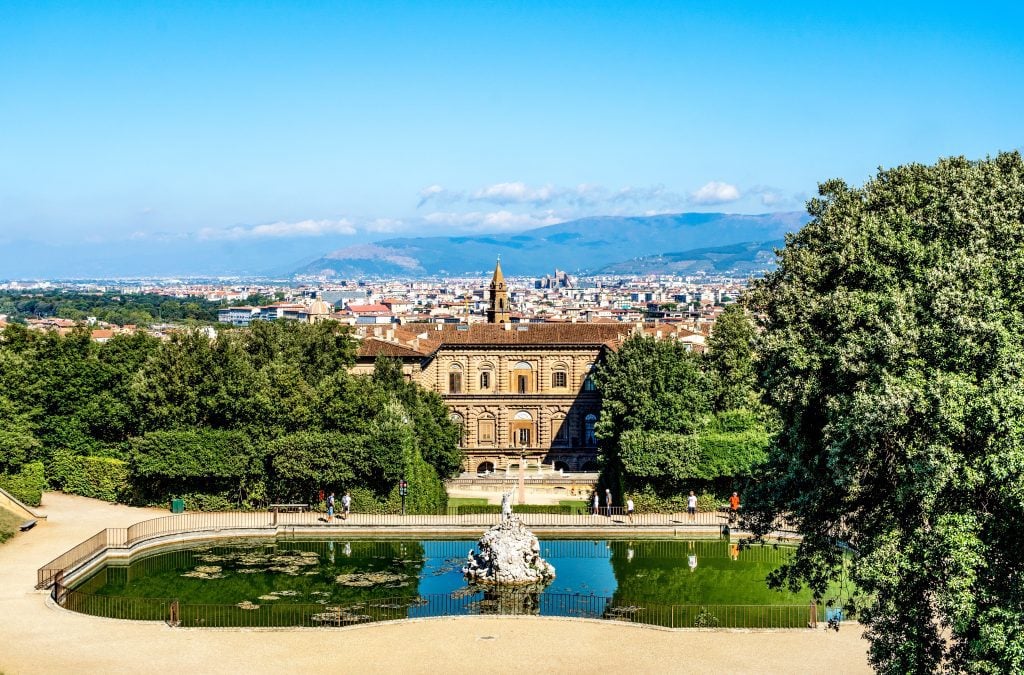
Pitti Palace and Boboli Gardens
Submitted by Cynthia of Sharing the Wander
The Pitti Palace in Florence is part of the famous Uffizi Gallery. From the Uffizi, walk across the Ponte Vecchio and into Oltrarno, where you’ll find this palace and the stunning Boboli Gardens behind it. Here you’ll find Medici treasures by painters like Rubens, as well as ivory figurines and golden platters.
The Pitti family built this palace, hence the name, but it was once the main residence of the famous Medici Family. The Medici bought the property in 1550; it was called the Grand Ducal residence and became a symbol of Medici Power.
The Boboli Gardens cover 111 sloping acres, and offer stunning views of Florence and its famous Duomo below. The Pitti Palace and Boboli Gardens each have separate entrance tickets, though both are included in the 5-day Uffizi Pass.
There are four sections to the Pitti: The Palantine Gallery and Royal Apartments, Gallery of Modern Art, the Treasury of the Grand Dukes, and the Museum of Costume and Fashion.
The Palantine Gallery and Royal Apartments are the highlight of the Pitti. You’ll walk through richly decorated rooms filled with world-class artworks. One of the first rooms you’ll see is the Sala Bianca, an all-white room filled with dazzling chandeliers, which is often used for events.
Consider doing a guided tour of the Pitti — the signage in the Palantine Gallery is minimal, and there are masterworks hiding in plain sight. You’ll also enjoy the palace more while hear stories about the Medici family.
Upstairs from the Palantine is the Gallery of Modern Art. “Modern” here simply means “not ancient.” You’ll see works from 1800 and earlier in this gallery space. In the Treasury of the Grand Duke you’ll find other art objects, from china to delicate figurines.
The Pitti Palace and Boboli Gardens are one of the best things to do in Florence with kids because it combines several things into one: extravagantly decorated rooms, world-class art, elegant costumes, and room to run around outside!
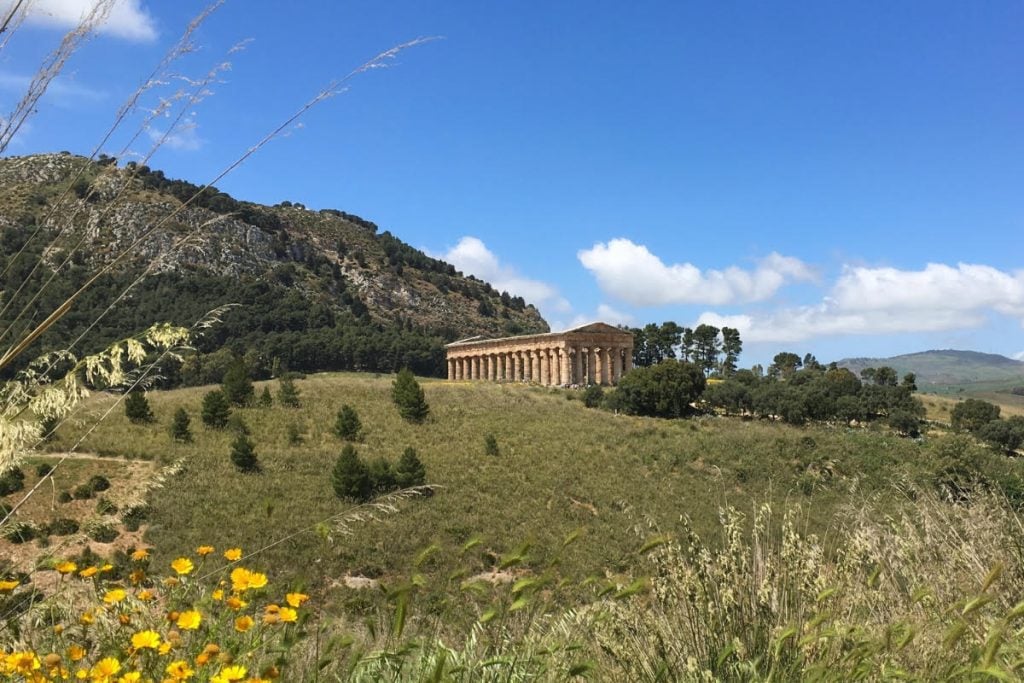
Segesta
Submitted by Izzy of The Gap Decaders
No trip to Western Sicily would be complete without visiting Segesta, home of the incredibly well-preserved ancient Greek Temple and Roman amphitheater.
One of Italy’s best-known landmarks, Segesta is set on a hillside with commanding views across the landscape, which just adds to the atmosphere of this beautiful place.
Important and influential through the ages, the original Elymian city of Segesta reached the peak of its wealth and power in the 5th century BCE, and controlled one of the largest mints in the region. During this period, Segesta also hosted an enormous market that attracted traders from all over Europe.
Towards the end of Segesta’s reign, around 417 BCE, the Doric temple was constructed (although never finished) at the foot of Mount Barbaro and represents the ancient city at the end of its zenith as Sicily was being drawn into international conflicts between Athens, Sparta, and Carthage.
Between Palermo and Trapani, Segesta is easy to get to by car, or with a guided tour from Palermo, around an hour away.
Visit in springtime for the fantastic wildflowers that carpet the site, in summer for lush green meadows, and in winter for a quieter and more peaceful experience.
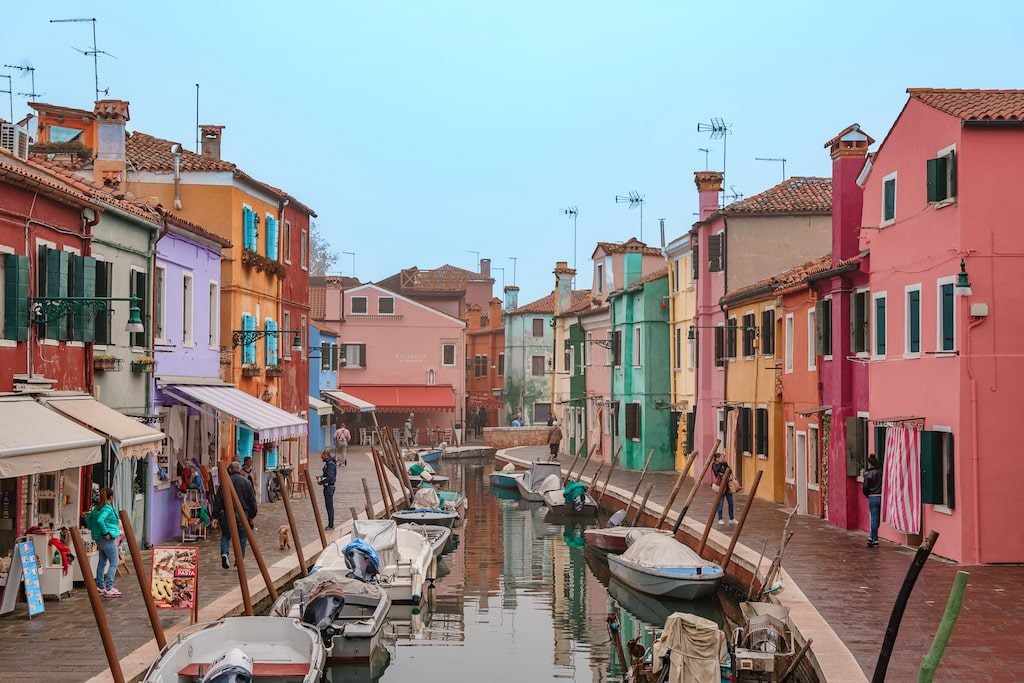
Burano
Submitted by Mal from Raw Mal Roams
As one of the most colorful towns in the world, Burano is a must-see Italy landmark when visiting Venice. The early settlement on Burano dates back to the 5th century. The legends say that the local fishermen painted the houses in vibrant colors to be able to see the island from a distance through the fog.
Today, the village is a popular tourist spot attracting visitors with its picturesque canals, seafood restaurants and souvenir shops.
Burano is also famous for its lacemaking. The local artisan workshops have produced hand-made lace since the 16th century, and although in the souvenir shops, you mostly can find machine-made lace, there are still shops, such as Martina Vidal Venice, that sell real-deal handmade lace.
Apart from shopping for lace, other things to do in Burano include strolling the delightful streets and taking photos of the pictures buildings and canals.
An excellent place to stop for lunch is In Pescaria Vecia, which serves fresh seafood, tapas dishes, and delicious passion fruit mojitos. The restaurant seating area overlooks the water and Venice in the distance and is also an excellent place to take a break from sightseeing.
To visit this iconic Italian island, book a tour or take a vaporetto (public transportation boat) from Venice. Burano is super small, so you will only need about half a day to explore it.
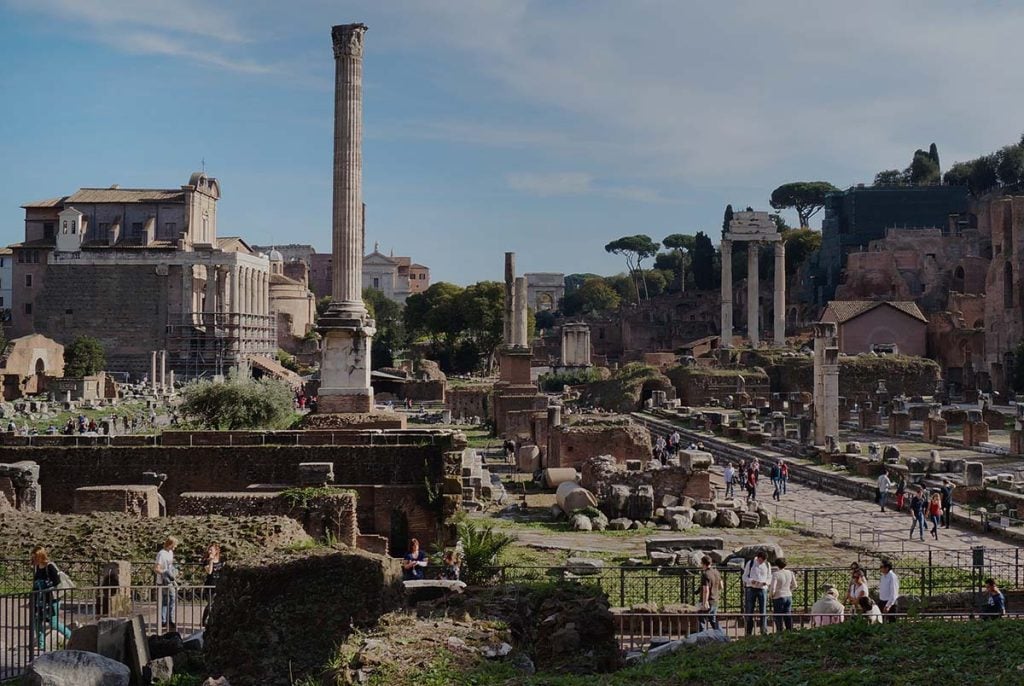
Roman Forum
Submitted by Paulina from UK Every Day
In the heart of Rome between Musei Capitolini and the Colosseum spans an archeological site that attracts millions of visitors every year. The Roman Forum is surrounded by unique Italian stone pines and world-famous Italy landmarks.
Set on an area of almost five acres, the Roman Forum has plenty of ruins to explore, including the House of the Vesta and the Medieval Portico.
The remains of the Temple of Saturn, dedicated to the god of time, stand proudly in the Roman Forum. Additionally, the Arch of Septimius Severus, Tarpeian Rock, and the Temple of Vespasian and Titus are even more examples of surviving structures.
The best time to visit Roman Forum is late afternoon. You can not only avoid the crowds but also admire an epic sunset over one of the most significant historic sites in Italy. During Italian riposo and early morning, the Roman Forum can be really busy.
One of the most convenient ways to visit the ancient sites of Rome is to book a tour that includes both the Roman Forum and the Colosseum.
Nevertheless, this famous Italian landmark has inspired people from all walks of life for generations.
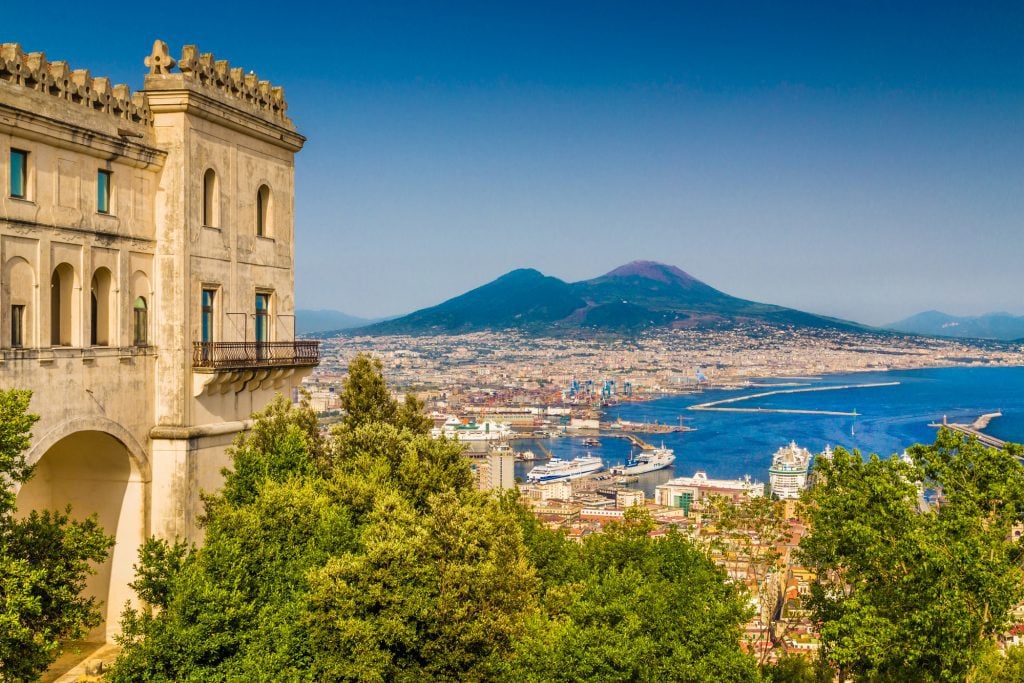
Mount Vesuvius
Submitted by Shireen from The Happy Days Travels
One of the most notable natural wonders in all of Europe, let alone in its homeland of Italy, majestic Mount Vesuvius towers over Naples. This is the only active volcano in Continental Europe and serves as a constant reminder of the threat it poses to the region — while also drawing thousands of tourists each year to see it in all its glory.
This landmark is repeatedly referenced in popular culture, featured in songs and documentaries. It’s also a common location for TV shows like The Sopranos filming in Naples, films like The Last Days of Pompeii, The Talented Mr. Ripley and Hand of God.
At 4,203 feet (1,281 meters), Vesuvius is said to have been here for more than 200,000 years and in its long life has caused destruction and rebirth, tragedy and admiration. The volcano is most famous for the eruption in 79 CE that completely buried the city of Pompeii. The most recent eruption was in 1944 and the potential for another eruption is ever-present.
Mount Vesuvius is a great natural wonder to see and is also famous for its San Marzano tomatoes, which grow on the fertile soil and are essential for traditional Neapolitan pizza.
If marvelling at Vesuvius from afar doesn’t feed your wanderlust enough, there are multiple tours and ways to get close to the volcano including visits to the crater and tours to the summit.
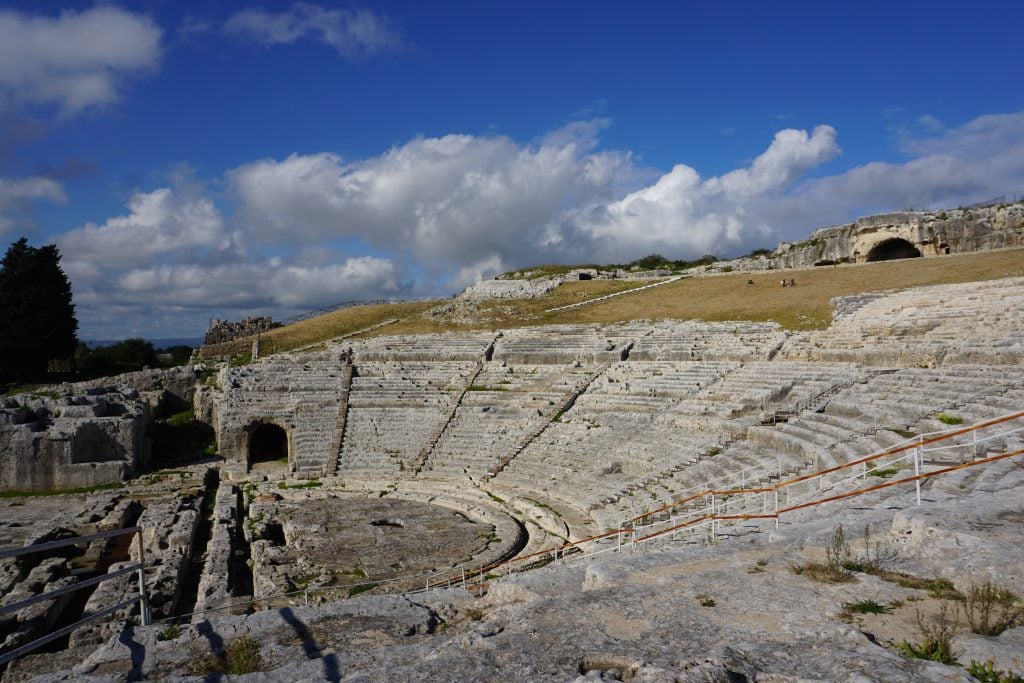
Neapolis Archeological Park, Siracusa
Submitted by Tamar of World by Weekend
From the Ancient Greeks and Romans to the Saracens and Normans, the Mediterranean island of Sicily has seen many cultures visit its shores. Each group has left its mark, and a good Sicily road trip will take you to a variety of fascinating archaeological sites. One such location is the Neapolis Archaeological Park in Siracusa.
This major landmark is home to the largest ancient Greek theater in the world. With sweeping views over the bay of Siracusa, this structure once held 15,000 spectators!
During the period of classical antiquity, locals flocked to the theater to watch plays and hear political speeches. Later, the ancient Romans altered the theater so they could flood the stage and hold ship battles for spectators. Now, in the summer months, visitors can get a taste of the ancient theater experience with regular showings of traditional Greek plays, performed in Italian.
In addition to the theater, the Neapolis Archeological Park also holds an ancient stone quarry and Roman hippodrome. Visiting the site is an opportunity to learn about the ancient city-state of Siracusa (the second largest city of the time after Athens), a dominant Greek power in the fifth-century BC and home to 150,000 people.
When you visit Siracusa, don’t miss spending time in Ortigia, the island that doubles as Siracusa’s gorgeous old town.
Read More: Where to Go in Eastern Sicily
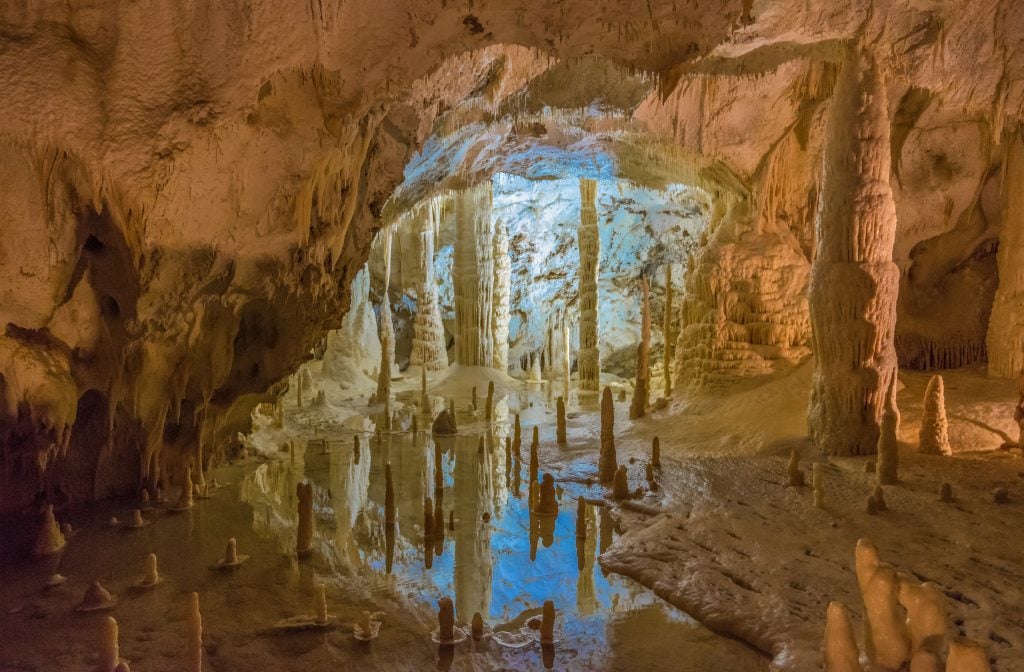
Frasassi Caves
Submitted by Alyssa of An Apple A Plane
Imagine being surrounded by dazzling crystal walls, twirling alongside turquoise waters feeling fresh, cool air all around you. It’s almost like a scene out of Frozen!
You can experience all of this at the Frasassi Caves in Genga, Italy, close to Ancona in the region of Le Marche. With hill towns and a gorgeous coastline, Le Marche has increased tourism over recent years despite its off-the-beaten-path location. Some call it the next Tuscany!
The Frasassi Caves were first discovered in 1971 and now represent one of Europe’s largest caving systems. These caves are exceptional within Italy because they provide visitors an immersion into the natural wonders of the country, often overlooked in favor of cathedrals and pasta.
Spend a magical hour and 15 minutes being guided through this majestic, live cave, hearing the slow drip of stalactite waters as you safely walk along a ramp. Experience all sensations in this serene environment, tucked away into Italy’s mountains.
The easiest ways to visit are by car, driving along Highway A14, or by train, departing at the San Vittore Terme Station. From here, it’s a 10-minute walk to the Frasassi Cave ticket office. Tickets can be purchased online in advance, and visitors are encouraged to arrive 30 minutes before their entry time.
Explorers can choose to ride a shuttle from the ticket office to the start of the caves, or walk just under one mile to the start. Wheelchair users will be able to access the first room of the caves.
If you’d like to see more of Italy’s underrated natural wonders, the Frasassi Caves are a great place to start!
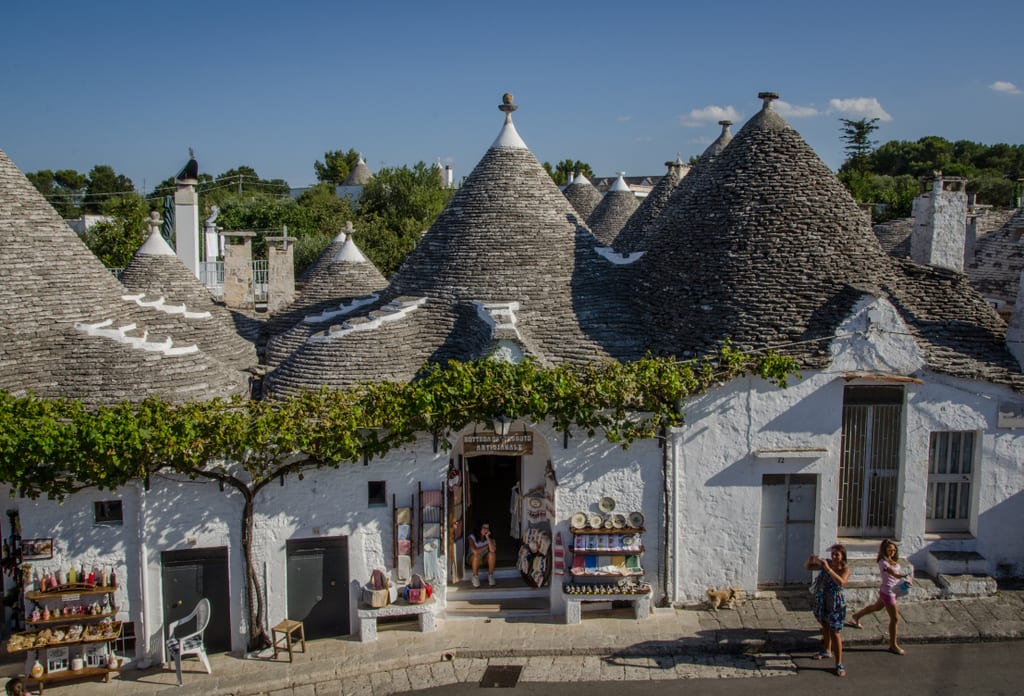
Trulli of Alberobello
Submitted by Kate of Our Escape Clause
Unique and immediately recognizable, the remarkable trulli of Alberobello are easily among the best landmarks to visit in Italy. In fact, trulli are one of the most iconic features of Puglia, and a must-see on any Puglia road trip.
Trulli are conical stone buildings (often centuries old) that are famously constructed without mortar, using prehistoric building techniques. While you can find trulli throughout Puglia’s inland Itria Valley, the highest concentration of trulli — by far — can be found in the town of Alberobello.
Alberobello alone is home to more than 1500 trulli, primarily concentrated in the districts of Rione Monti and Rione Aia Piccola, and the town’s trulli are recognized as a UNESCO World Heritage Site.
Thanks to its unique architecture, UNESCO status, and endless charm, Alberobello is one of the most popular places to visit in Puglia, and gets understandably crowded.
To make the most of your visit, try to wander off the beaten path: while visiting famous spots like the large Trullo Sovarno or photogenic Trullo Siamese are certainly worth it, most of Alberobello’s visitors don’t make it down the quieter streets, where you can often find yourself alone with the structures.
Souvenir shops in Alberobello have something special to offer as well: for the price of a cold drink or a small trinket, you can often climb to their roofs to appreciate the trulli from above!
None of this, however, compares to the best way to experience the trulli of Alberobello, which is to rent a trullo to stay in overnight.
Not only will this allow you to fully appreciate the construction of the trulli (they stay remarkably cool!), but will allow you to appreciate Alberobello without the crowds of daytrippers in the morning and evening.
Read More: The Trulli of Alberobello
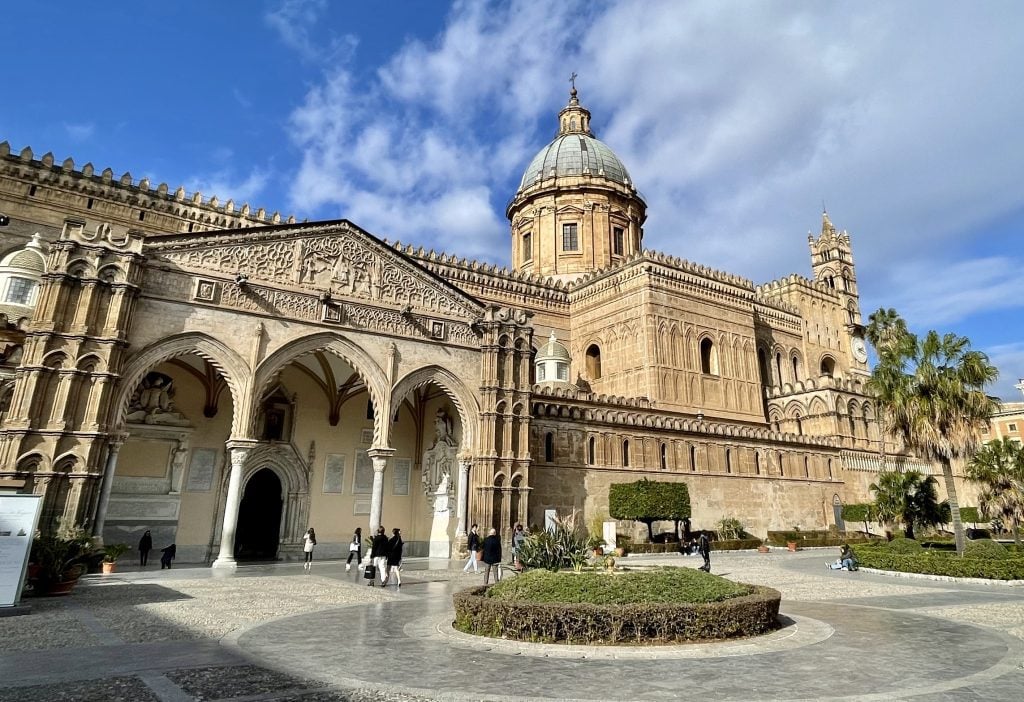
Arab-Norman Palermo
Submitted by Catrina of 24 Hours Layover
For a landmark city you must visit at least once in your lifetime, head to Palermo, the largest city in Sicily. Palermo is incredibly special as it wins the title for the most UNESCO World Heritage Sites in Italy — plus, it’s the most conquered city in the world!
Palermo is incredibly beautiful and the architecture is so impressive and different from the rest of Italy due to its unique history. It has a real mix of Arab-Norman and Baroque architecture styles which is fascinating to see.
Palermo’s most famous landmarks are the Cathedral, the Cappella Palatina, and the unique San Cataldo Church, built in 1154.
What’s incredibly unique is that many of the churches in Palermo were converted into mosques when the Moors invaded, then they were converted back into churches when they left 200 years after, so many churches here have unique red domes on the top.
The great thing is that Palermo is very compact so you can walk between all the sites easily. Plus, with year-round sunny weather, beautiful beaches, stunning architecture, delicious food, and lower costs than the rest of Italy, there’s no reason not to book that trip to Palermo!
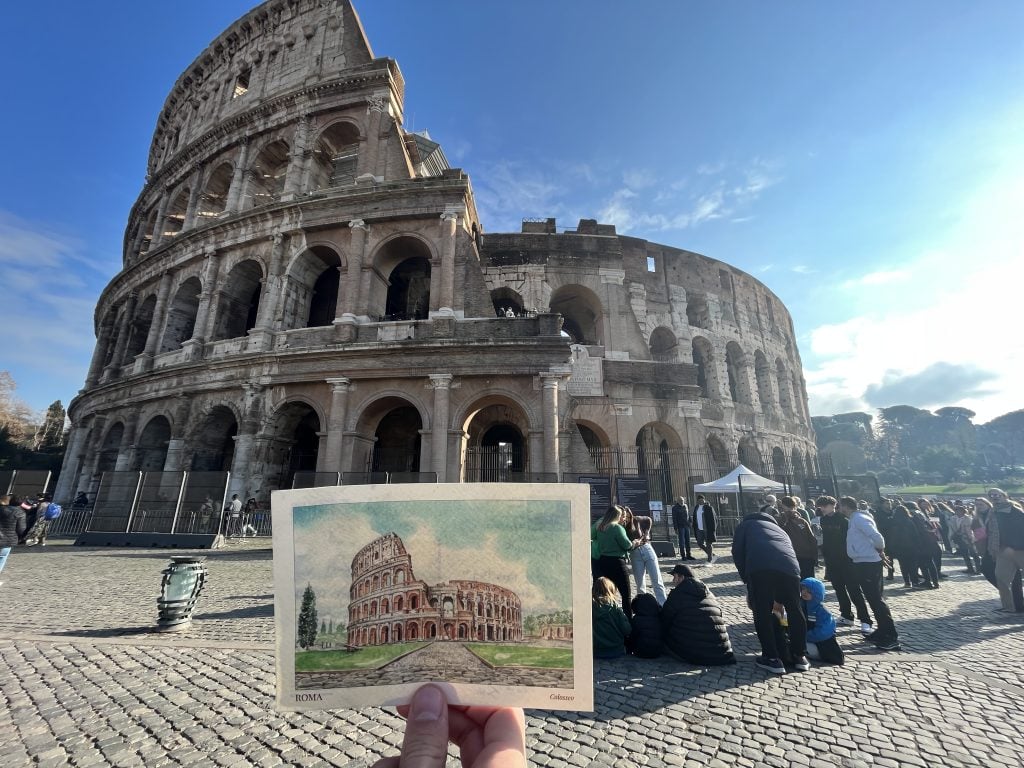
The Colosseum
Submitted by Josh of A Backpacker’s World
The Colosseum is one of the most iconic landmarks in Italy. The beautiful 2000-year-old Ancient Roman Amphitheatre is the biggest and most popular attraction in Rome, drawing more than 6 million visitors each year.
Stepping foot inside the Colosseum means you are simultaneously stepping back in time, witnessing life at its most brutal in Ancient Rome.
Getting your iconic photo of the Colosseum alone makes Rome worth visiting. Seeing the Colosseum during the daytime is special, but it’s a good idea to visit at night as well, as it looks so interesting and beautiful in different kinds of light. When the lights create a yellow-orange glow on the Colosseum, it’s indescribable. The mood and atmosphere around the Colosseum completely change, it’s a sight to see, to say the least.
The Colosseum is one of the most popular Italy landmarks, but it is popular for a reason, and everyone should aim to see the Colosseum when visiting Italy.
You can get skip-the-line tickets to the Colosseum here, or book a Colosseum and Roman Forum tour.
Planning a Trip to Italy:
- What NOT to Do in Italy
- Solo Female Travel in Italy: Is it Safe?
- Ultimate Guide to Driving in Italy
- How to Stay at an Agriturismo in Italy
- 30 Stunning Mediterranean Islands To Visit In Your Lifetime
- 30 Italian Cities To Visit Once In Your Lifetime
Cool Places in Southern Italy:
- Tropea, Italy: A Spectacularly Situated Beach Town
- The Stunning Trulli of Alberobello, Italy
- 16 Fun Things To Do In Sorrento
- 17 Fun Things to do in Bari, Italy
- 16 Fab Things to do in Lecce, Italy
- 15 Best Things to do in Monopoli, Italy
- 17 Fun Things to do in Matera, Italy
Cool Places in Sicily:
- 22 Best Places to Visit in Sicily
- The Joys and Challenges of Traveling in Sicily
- Where to Go in Eastern Sicily
- 23 Fun Things to Do in Palermo, Sicily
- Complete Guide to the Aeolian Islands, Sicily
- Aci Trezza: A Laid-Back Coastal Town in Sicily
- Visiting Sicily in the Winter: Worth it or not?
- 30 Iconic Dishes To Try In Sicily
Cool Places in Northern Italy:
- Three Weeks in Northern Italy: An Itinerary
- Parma, Italy: A Colorful, Artsy, Delicious Town
- Where to Stay in Rome: Best Neighborhoods and Accommodation
- Three Days in the Dolomites: A South Tyrol Getaway
- Best Day Trips from Florence, Italy
- The Immaculate, Bursting Mosaics of Ravenna, Italy
- 25 Best Food Experiences in Emilia-Romagna, Italy
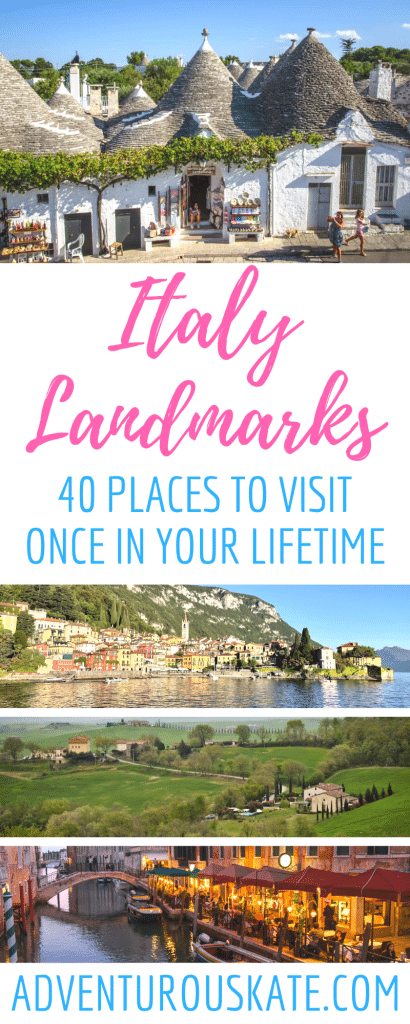
What are your favorite Italy landmarks? Share away!